Ever walked through a tropical resort and thought, "I wish my backyard looked like this"? Well, you're in luck. Whether you've got a sprawling yard or just a tiny balcony, creating your own slice of paradise is totally doable. We're talking lush palm groves, dramatic elephant ears, soothing water features, and even some clever tricks for beginners who think they can't keep a cactus alive. From tiki-themed party spaces to romantic evening retreats, these 20 ideas will show you exactly how to transform any outdoor space into a tropical escape that'll make your neighbors seriously jealous.
1. Lush Layered Tropical Garden Canopy Design

Creating depth through strategic plant placement defines this tropical garden approach that mimics natural rainforest structure. Position tall palms like Cuban Royal or Foxtail varieties as your overhead canopy, providing dappled shade below. Beneath these giants, establish a middle layer with banana plants, large-leafed elephant ears, and colorful cannas that reach four to six feet in height. Ground level features ferns, begonias, and hostas that thrive in filtered light conditions. This layering technique creates visual interest while establishing natural microclimates that support diverse plant communities. The overlapping heights generate a jungle-like atmosphere where each plant contributes to the overall lushness. Dense planting enhances the tropical feeling while providing privacy and creating cool, shaded retreats within your garden space.
2. Container Tropical Garden Mobility Paradise

Maximize flexibility with this portable tropical garden concept perfect for renters, seasonal climates, or changing design preferences. Large containers house statement plants like dwarf banana trees, compact palms, and architectural elephant ears that can be repositioned as needed. Medium-sized pots feature colorful cannas, hibiscus, and crotons that provide seasonal blooms and foliage interest. Small containers with trailing plants like sweet potato vine and colorful coleus create edges and fill gaps between larger specimens. This approach allows you to bring tender tropicals indoors during colder months while creating stunning summer displays. Group containers in odd numbers and vary heights using plant stands or elevated surfaces. The mobility factor enables you to experiment with different arrangements and protect investments in premium tropical specimens throughout changing seasons.
3. Water Feature Tropical Garden Oasis Sanctuary

Integrate the soothing presence of water with tropical plantings to create a resort-style retreat in your backyard. Install a central fountain or pond surrounded by moisture-loving plants like papyrus, water cannas, and elephant ears that naturally thrive near water sources. Position palms and bamboo to create privacy screens while adding vertical elements that frame water views. Include flowering tropicals like hibiscus and bird of paradise near seating areas to provide color and fragrance. The sound of flowing water masks urban noise while creating a meditative atmosphere enhanced by the gentle rustling of palm fronds. Strategically placed lighting illuminates both water movement and plant textures after dark. This combination transforms ordinary yards into tranquil escapes where the interplay between water and tropical vegetation creates an immersive sensory experience.
4. Poolside Tropical Garden Resort Escape
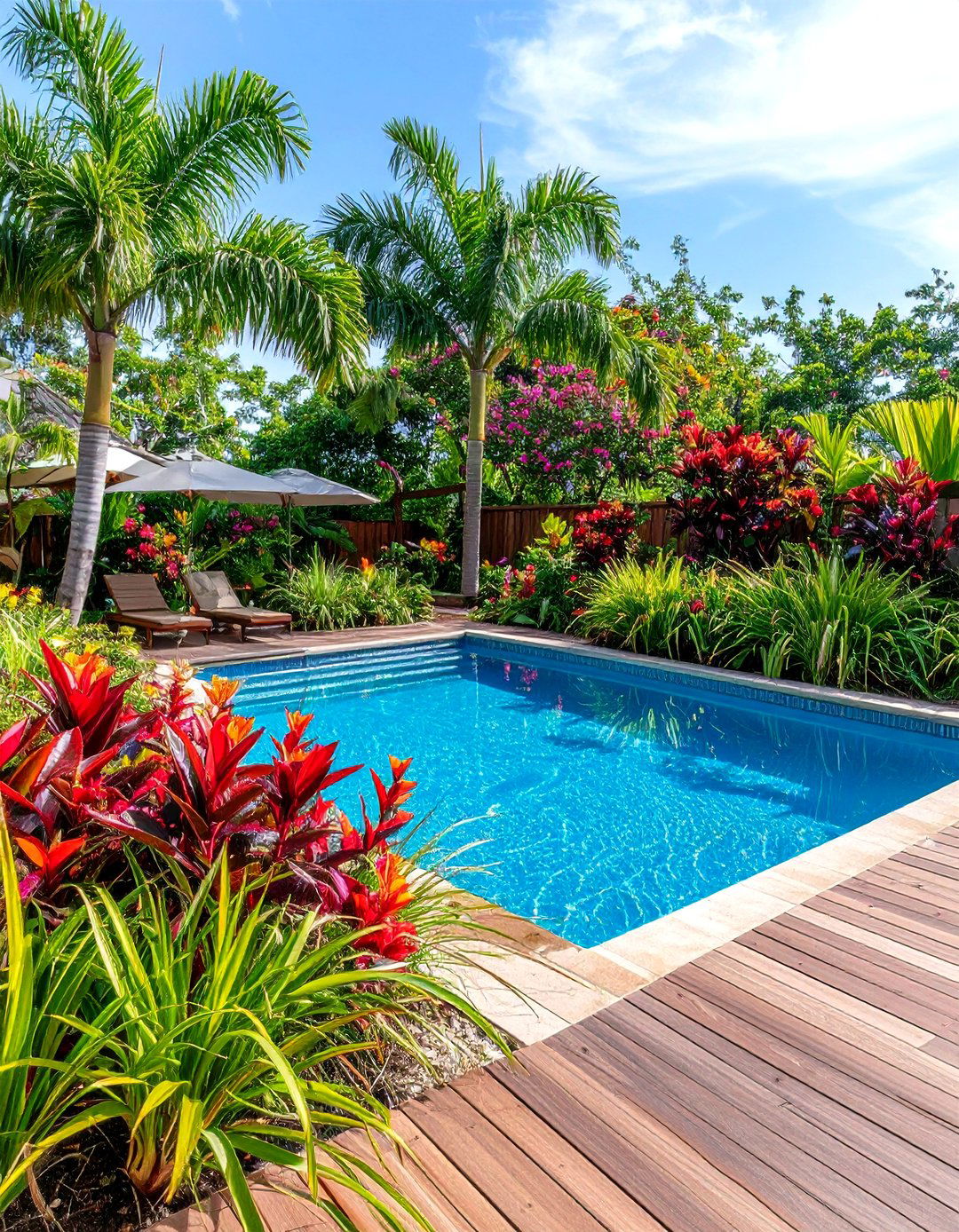
Transform your pool area into a private tropical resort with carefully selected plants that enhance rather than compete with water features. Plant heat-tolerant palms like Bismarck or Date palms in strategic locations that provide afternoon shade without dropping excessive debris into pool water. Surround decking with low-maintenance tropical options including colorful crotons, compact hibiscus varieties, and ornamental grasses that withstand reflected heat and occasional splashing. Create visual barriers using bamboo clumps or large planters filled with architectural specimens like bird of paradise or giant elephant ears. Incorporate container gardens with moveable tropical plants that can be repositioned for parties or seasonal changes. This design balances the practical needs of pool maintenance with the aesthetic goals of tropical ambiance, resulting in an environment that feels like an exclusive resort destination.
5. Bamboo Grove Tropical Garden Privacy Screen

Establish a serene tropical garden atmosphere using bamboo as the primary structural element while maintaining manageable growth patterns. Select clumping bamboo varieties like Black Bamboo or Asian Lemon Bamboo that provide privacy without aggressive spreading behavior. Underplant bamboo groves with shade-tolerant tropicals including cast iron plants, colorful begonias, and various fern species that appreciate the filtered light conditions. Add seasonal interest with flowering plants like gingers and costus that bloom in bamboo understory environments. The vertical lines of bamboo stems create natural architectural elements while their rustling leaves provide gentle background sounds. This approach works particularly well for creating defined garden rooms or screening unsightly views while maintaining an authentic tropical feeling. The combination offers year-round structure through bamboo's evergreen nature complemented by seasonal changes in understory plantings.
6. Palm-Centered Tropical Garden Resort Theme
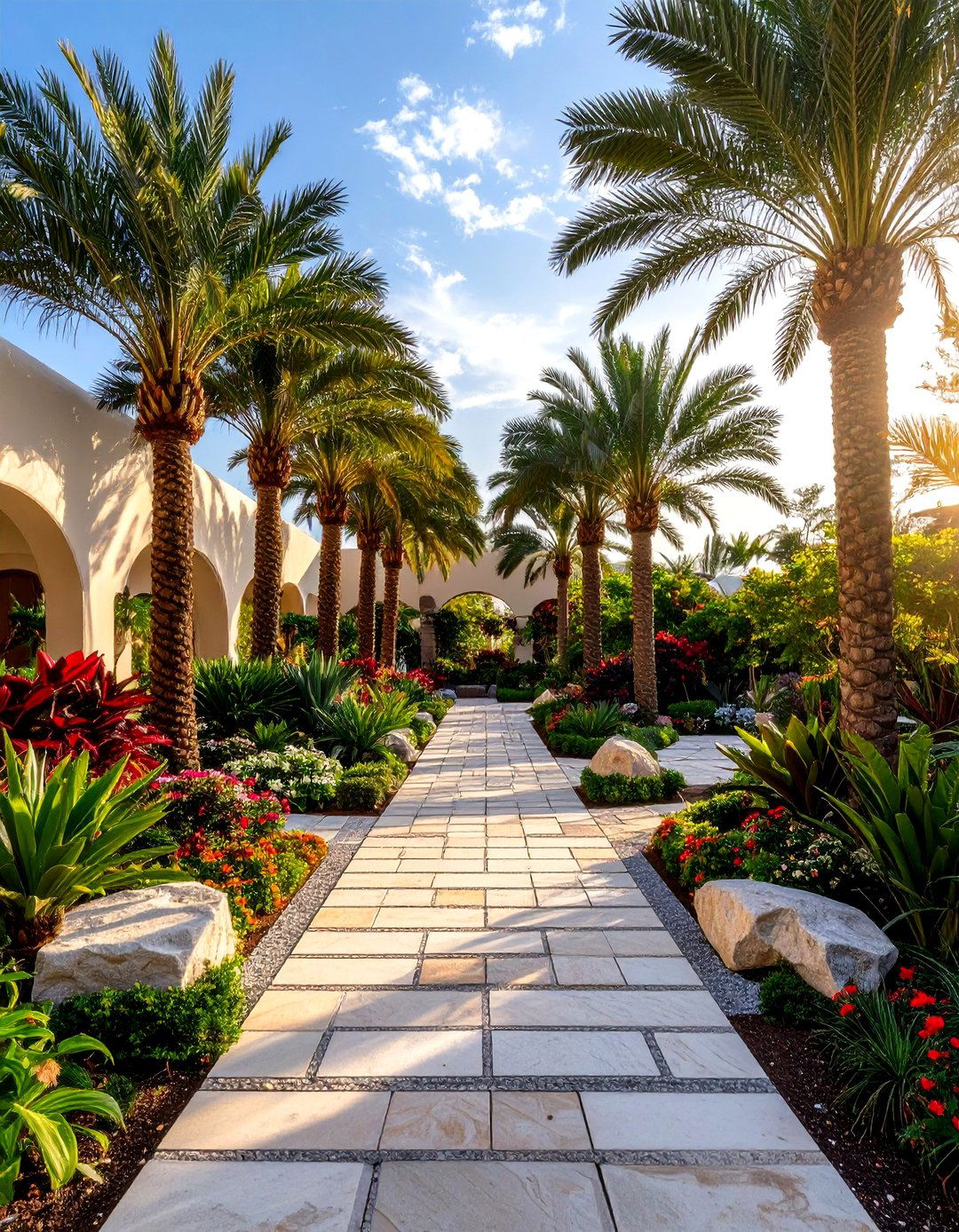
Design around magnificent palm specimens to create an authentic tropical garden that captures the essence of island destinations. Choose palms suited to your climate zone, from cold-hardy Windmill palms in cooler areas to spectacular Royal palms in warm regions. Arrange palms in natural-looking clusters rather than formal rows, varying species and sizes to create visual interest and depth. Underplant with tropical groundcovers like bromeliads, colorful caladiums, and flowering impatiens that complement rather than compete with palm architecture. Include pathway materials like decomposed granite or stone pavers that echo tropical resort walkways. Position seating areas to take advantage of palm shade while maintaining views of the overall garden composition. This palm-focused approach creates an unmistakable tropical atmosphere that serves as a daily reminder of vacation destinations and island paradises.
7. Colorful Canna Tropical Garden Festival Display
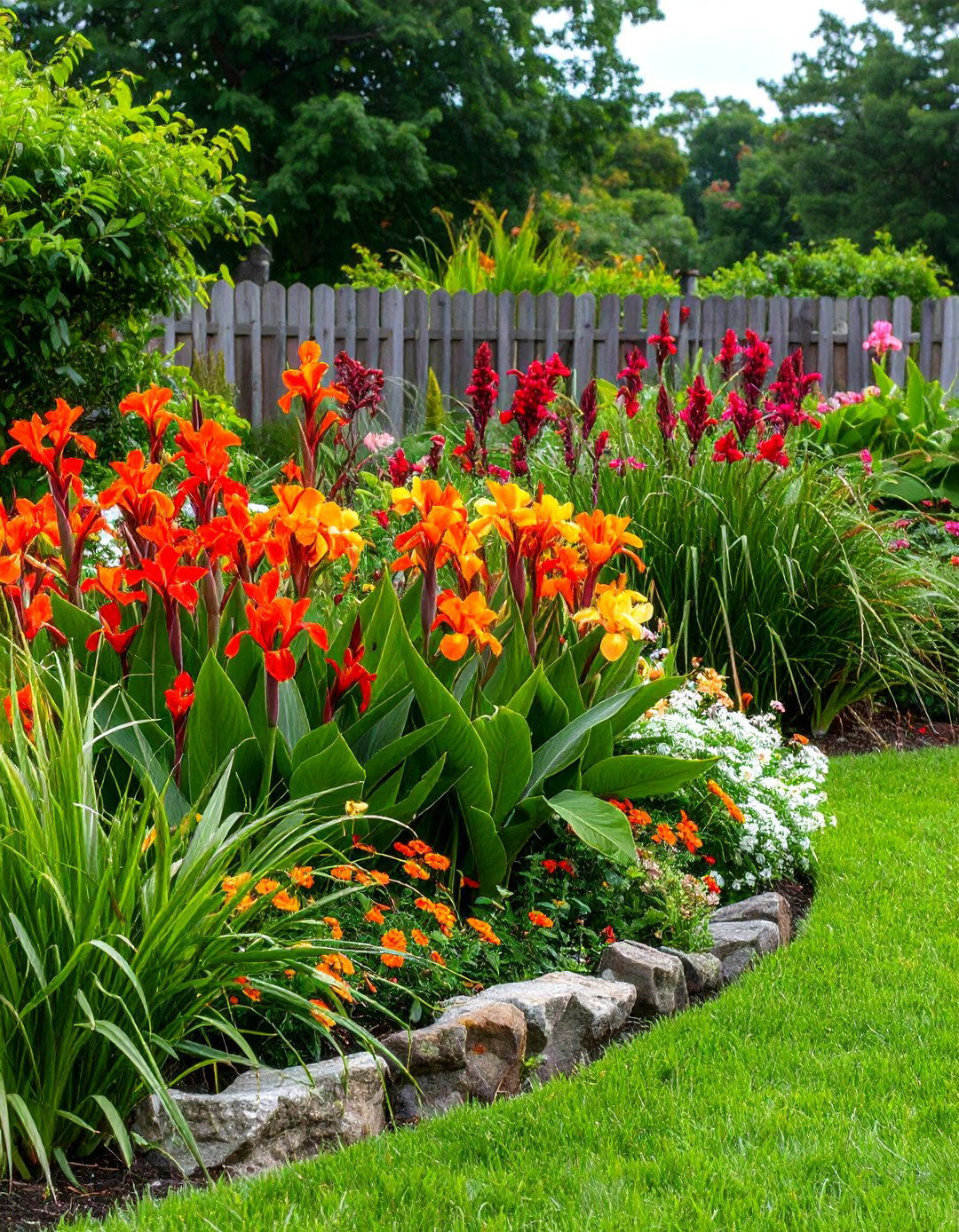
Celebrate vibrant tropical colors through strategic canna lily plantings that provide months of spectacular blooms and architectural foliage. Select canna varieties with different bloom colors including fiery oranges, passionate reds, sunshine yellows, and tropical pinks that create a festival atmosphere in garden beds. Combine solid-colored varieties with striped-foliage options like 'Pretoria' or 'Tropicanna' that offer visual interest even when not flowering. Companion plants include elephant ears for contrasting leaf shapes, colorful coleus for extended season interest, and ornamental grasses that add movement and texture. Mass plantings of single varieties create bold statements while mixed plantings offer complex color combinations. This tropical garden approach emphasizes the dramatic scale and intense colors that define tropical environments, creating outdoor spaces that energize and inspire through their bold visual impact and extended blooming seasons.
8. Shade-Loving Tropical Garden Understory Haven
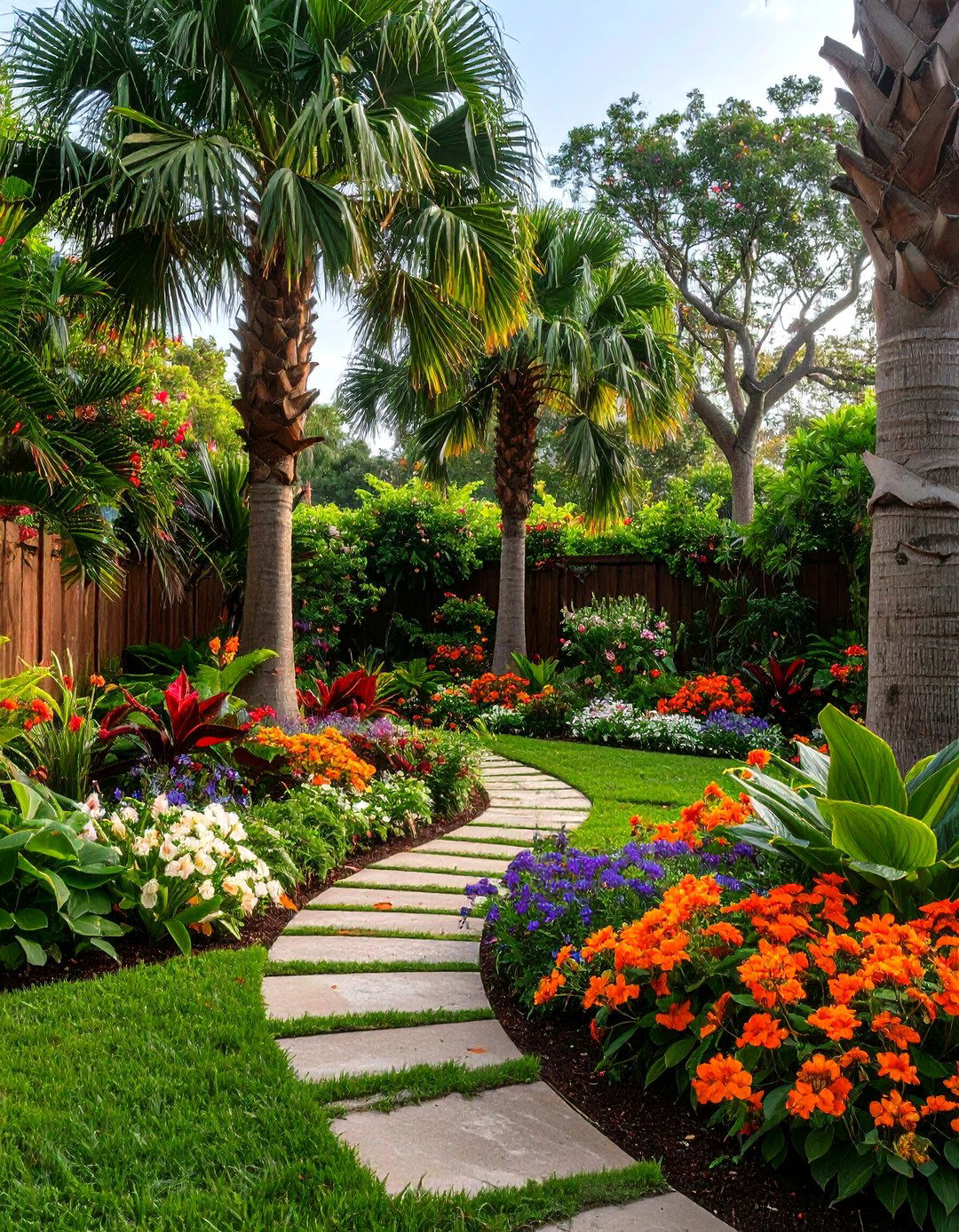
Transform challenging shaded areas into lush tropical retreats using plants that naturally thrive in low-light conditions. Establish structure with shade-tolerant palms like Parlor palms or Bamboo palms that provide vertical elements without requiring full sun exposure. Fill middle layers with large-leafed plants like elephant ears, caladiums, and begonias that offer colorful foliage in shaded conditions. Ground level features include ferns, hostas with tropical-looking varieties, and colorful impatiens that provide seasonal blooms. This approach works particularly well under existing tree canopies or in courtyards where buildings create natural shade conditions. The result challenges common assumptions about tropical gardens requiring full sun while creating cooling, restful spaces that offer respite from bright, hot areas. Shade-loving tropical gardens provide intimate environments perfect for reading, meditation, or quiet conversations.
9. Tiki-Themed Tropical Garden Entertainment Paradise
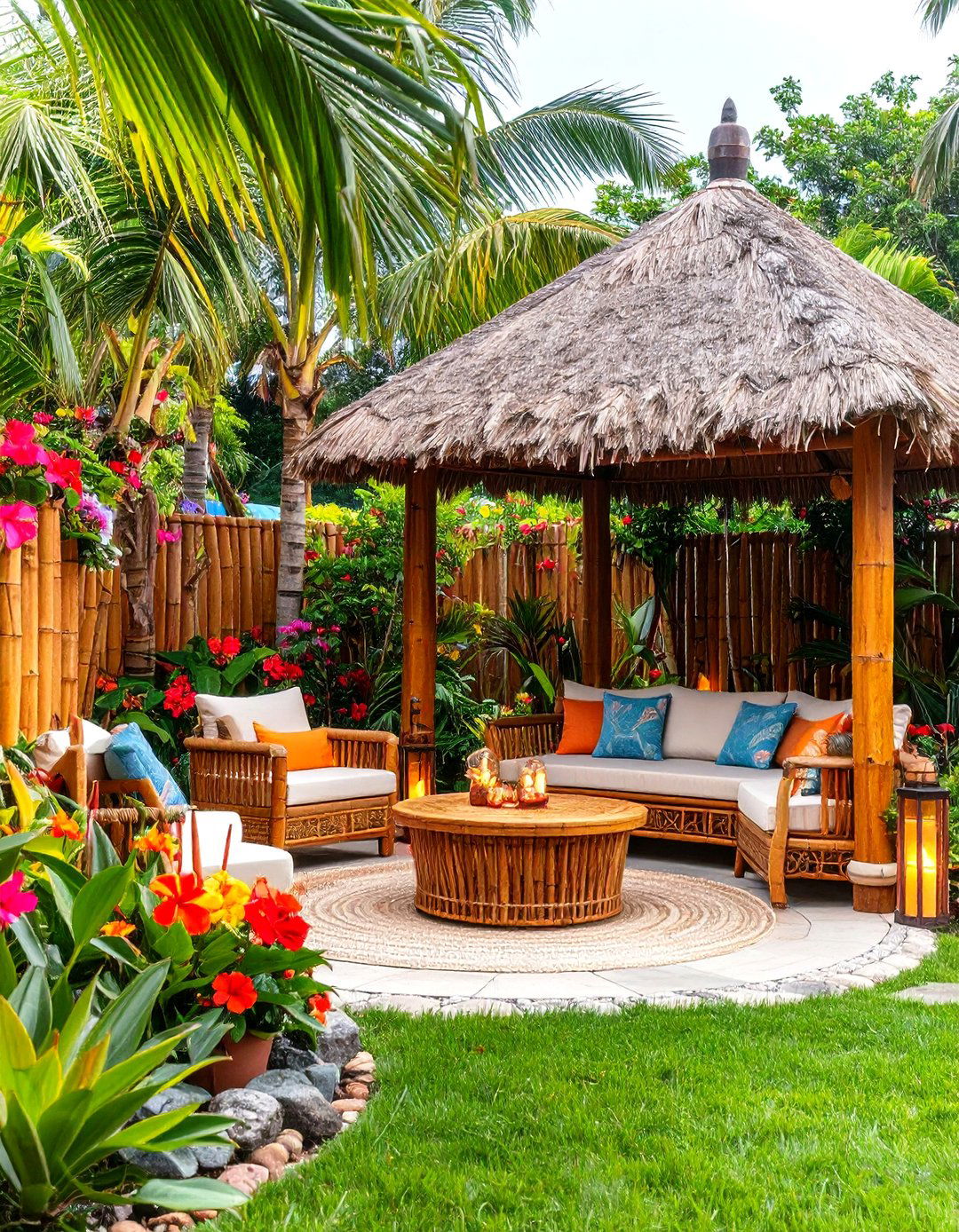
Create an immersive tropical entertainment space that combines exotic plantings with themed decorative elements for memorable outdoor gatherings. Establish bamboo groves and palm clusters to provide natural privacy screens while setting the tropical stage for themed furniture and lighting. Include flowering plants like hibiscus, plumeria, and bird of paradise that provide authentic tropical color and fragrance. Install tiki torches along pathways and seating areas to provide evening ambiance while offering natural insect control through citronella fuel options. Add water features like bamboo fountains or small ponds that enhance the island atmosphere with soothing sounds. Include tropical-themed seating areas with weather-resistant furniture in natural materials like teak or rattan. This comprehensive approach transforms ordinary backyards into immersive tropical experiences perfect for themed parties, family gatherings, or romantic evening entertaining under starlit skies.
10. Miniature Tropical Garden Courtyard Jewel
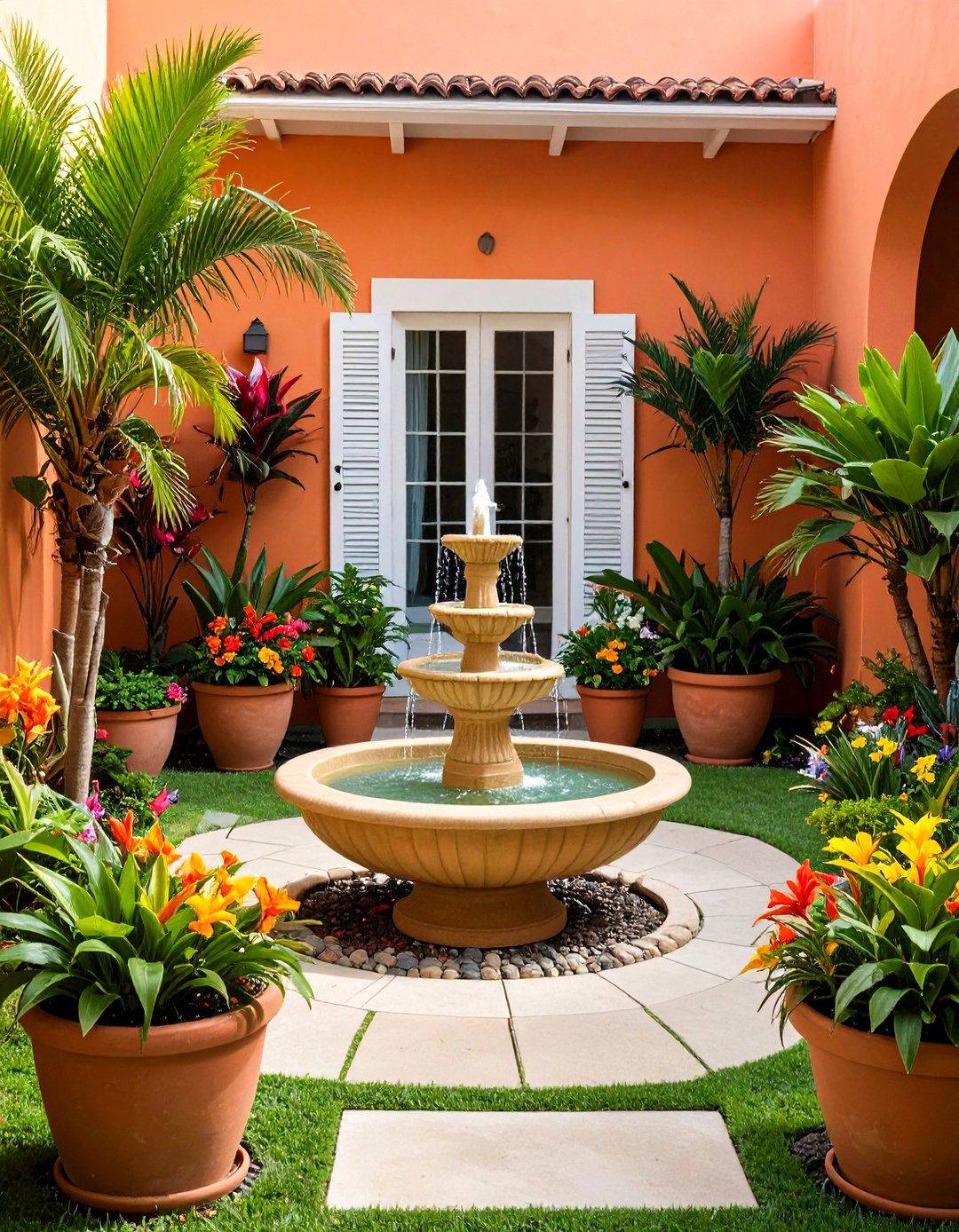
Maximize limited space with intensive tropical plantings that create significant impact in small areas like courtyards, patios, or balconies. Select compact tropical varieties including dwarf palms, small-statured elephant ears, and container-friendly cannas that provide tropical character without overwhelming small spaces. Utilize vertical growing techniques with trellises supporting tropical vines or wall-mounted planters filled with colorful bromeliads and air plants. Include a small water feature like a tabletop fountain that adds tropical ambiance without consuming valuable floor space. Layer different container heights to create depth and visual interest while maximizing planting opportunities. Choose plants with extended interest like variegated foliage options or long-blooming varieties that justify their space allocation. This concentrated approach proves that authentic tropical garden experiences require enthusiasm rather than extensive acreage, creating private paradise retreats in urban environments or compact living situations.
11. Vertical Tropical Garden Living Wall Spectacle
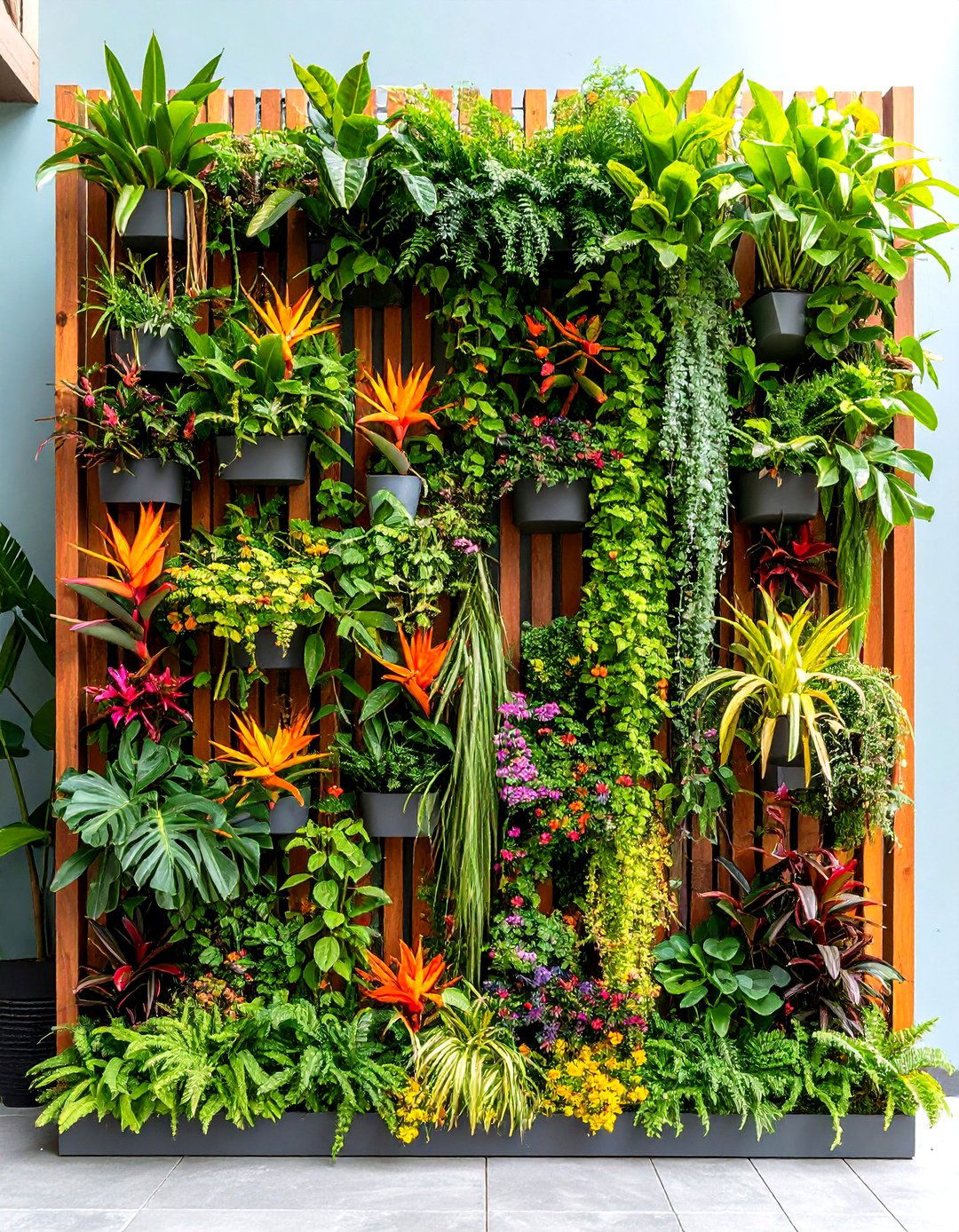
Transform blank walls or fences into stunning tropical displays using vertical gardening techniques that maximize planting space while creating dramatic focal points. Install trellis systems or living wall structures that support climbing tropical plants like passion vines, tropical jasmine, and colorful bougainvillea varieties. Include mounted planters at various heights filled with air plants, small bromeliads, and trailing tropical options that cascade downward for layered visual effects. Position larger containers at the wall base featuring architectural plants like bird of paradise or banana plants that provide structural elements while supporting the vertical display. This approach works particularly well in narrow spaces where horizontal planting options are limited but vertical surfaces offer opportunities for creative tropical expressions. Vertical tropical gardens serve as living artwork that changes seasonally while providing privacy screening and noise reduction benefits in urban environments.
12. Elephant Ear Tropical Garden Drama Theatre
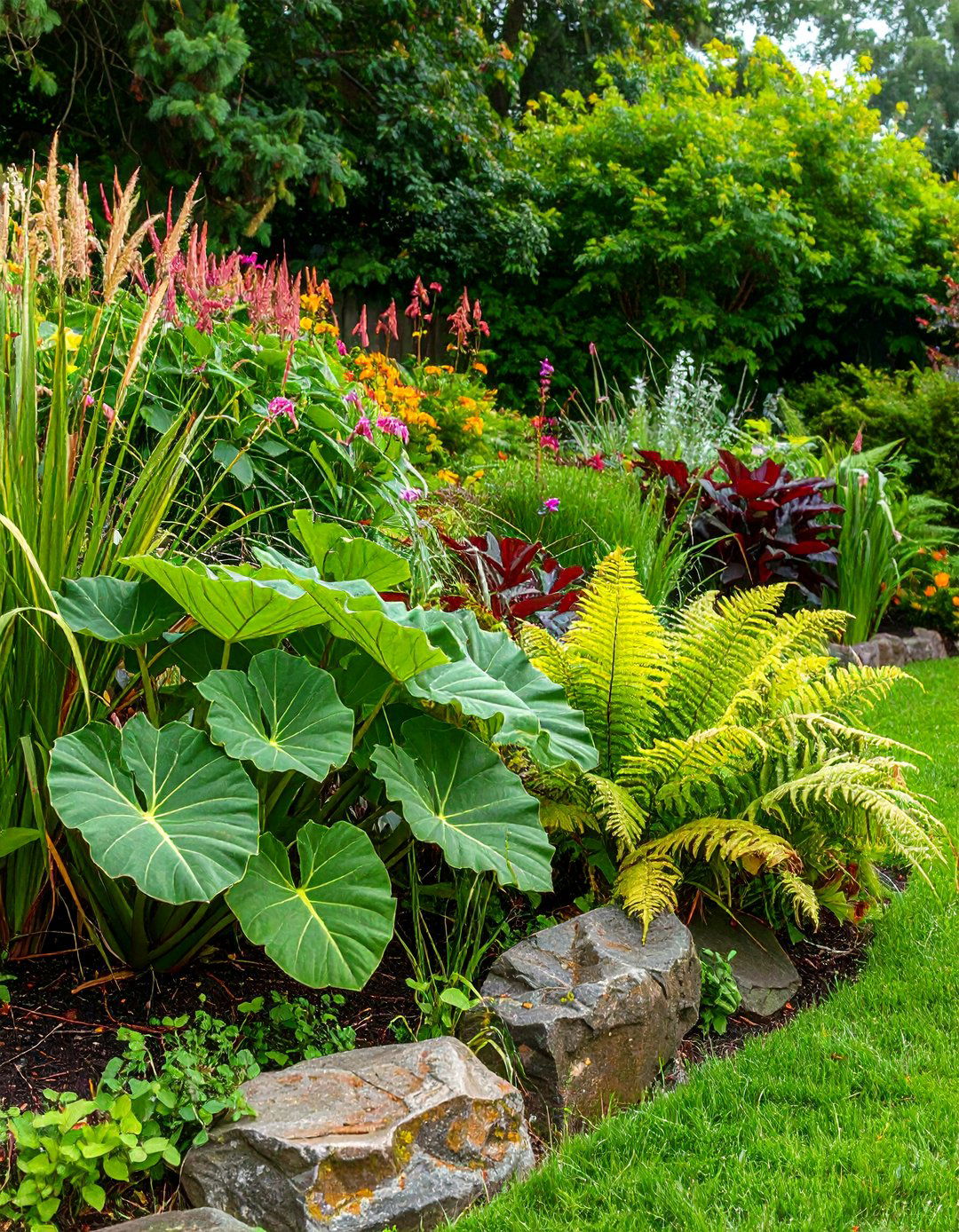
Showcase the magnificent foliage of elephant ear plants as the starring elements in dramatic tropical garden compositions that emphasize architectural plant forms. Select multiple elephant ear varieties including giant species like 'Thai Giant' for maximum impact, colorful options like 'Black Magic' for contrast, and medium varieties like 'Illustris' for layered effects. Companion these dramatic specimens with plants that complement rather than compete, including ornamental grasses, ferns, and flowering annuals that provide color without overwhelming the elephant ear display. Position elephant ears near seating areas where their impressive scale can be fully appreciated while creating natural privacy screens. Include appropriate lighting to highlight the dramatic leaf shapes during evening hours. This focused approach creates tropical gardens with undeniable impact where the magnificent foliage architecture becomes the primary design element supported by carefully chosen complementary plantings.
13. Evening-Lit Tropical Garden Romance Setting
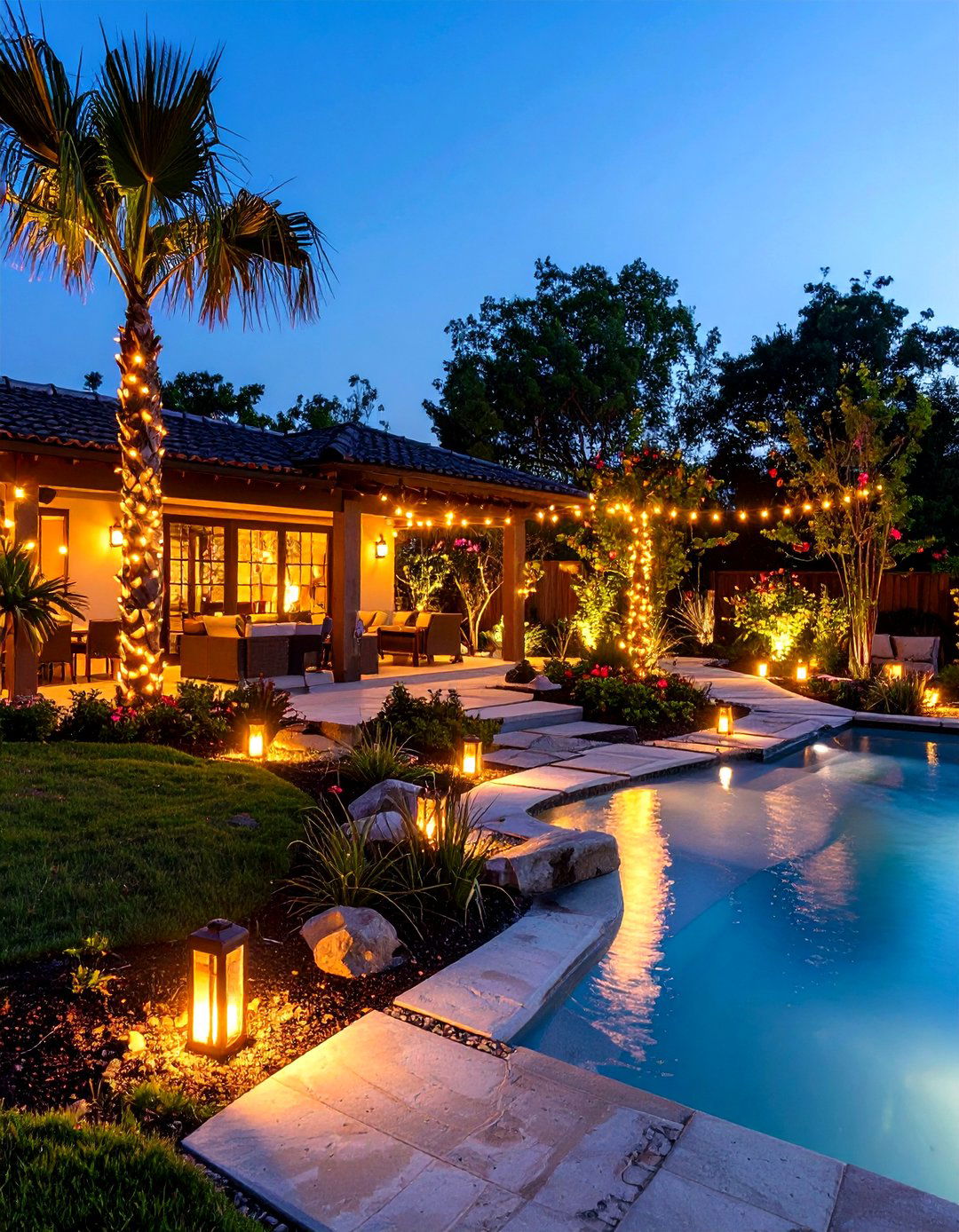
Design tropical gardens that transform into magical evening environments through strategic lighting that highlights plant textures and creates intimate atmospheres. Install LED spotlights that uplight palm trunks and highlight architectural plant forms like large elephant ears or bamboo groves. String warm-white lights through tree canopies or along fence lines to create overhead illumination that mimics moonlight filtering through tropical vegetation. Include pathway lighting using solar-powered tiki torches or low-voltage LED fixtures that provide safe navigation while maintaining tropical ambiance. Position accent lighting near water features to highlight movement and reflection while extending visual interest after dark. This lighting-focused approach extends garden enjoyment into evening hours while creating romantic settings perfect for intimate dinners, quiet relaxation, or entertaining guests under the stars. Evening lighting transforms tropical gardens into completely different environments after sunset.
14. Beginner-Friendly Tropical Garden Starter Collection
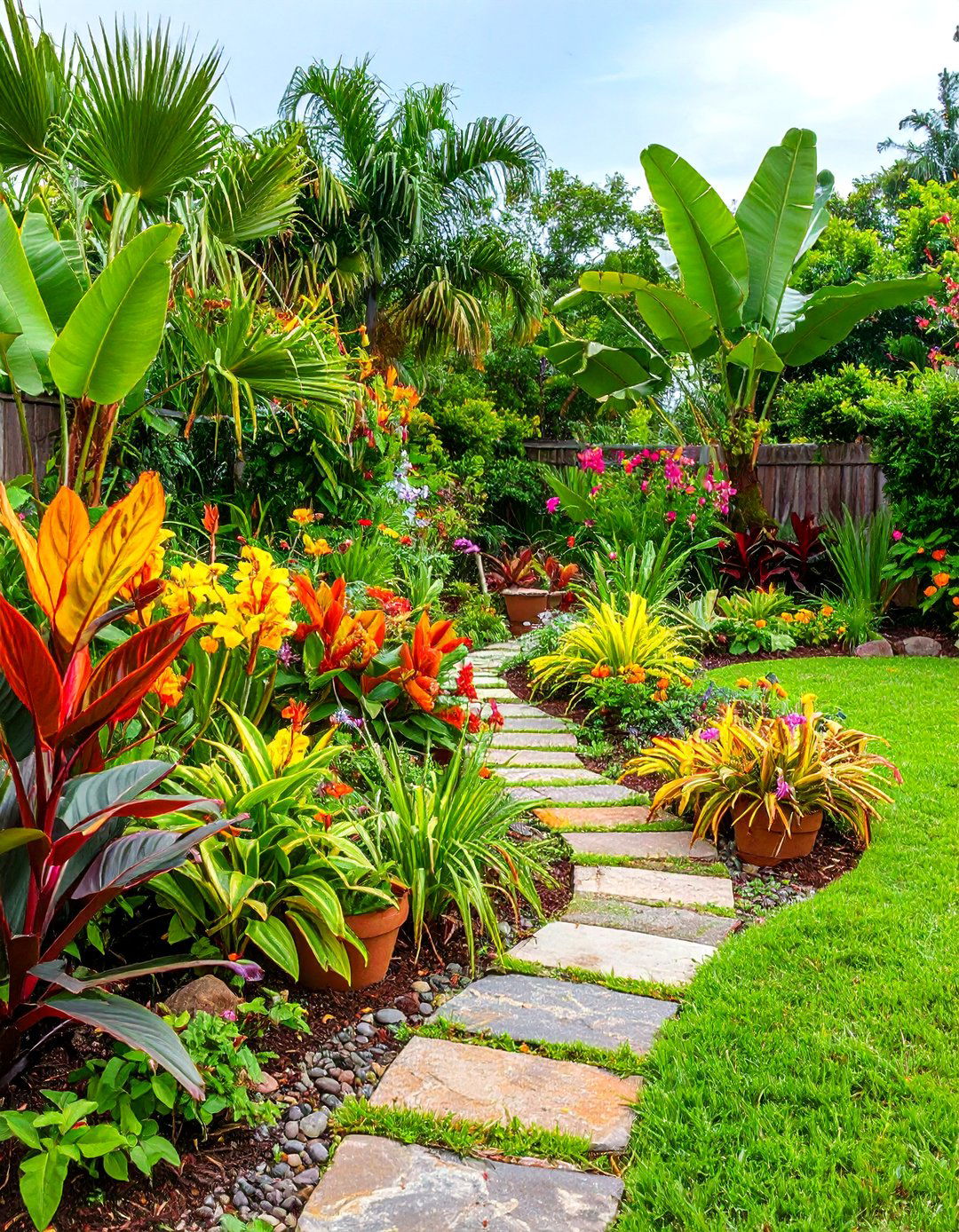
Establish successful tropical gardens using reliable, low-maintenance plants that provide authentic tropical character while forgiving novice mistakes. Begin with hardy palms like Windmill or Pindo palms that tolerate various conditions while providing essential tropical structure. Include easy-care tropicals like elephant ears, cannas, and hibiscus that offer dramatic results with basic watering and feeding requirements. Add container plants that can be moved to protected locations during challenging weather while allowing experimentation with different varieties and positions. Choose plants with extended growing seasons or interesting foliage that provide value beyond just flowering periods. This approach builds confidence through early successes while establishing foundations for more complex tropical gardening adventures. Beginner-friendly tropical gardens prove that creating exotic outdoor environments doesn't require extensive horticultural expertise, just enthusiasm for bold plants and willingness to learn through hands-on experience.
15. Tropical Garden Pathway Adventure Journey
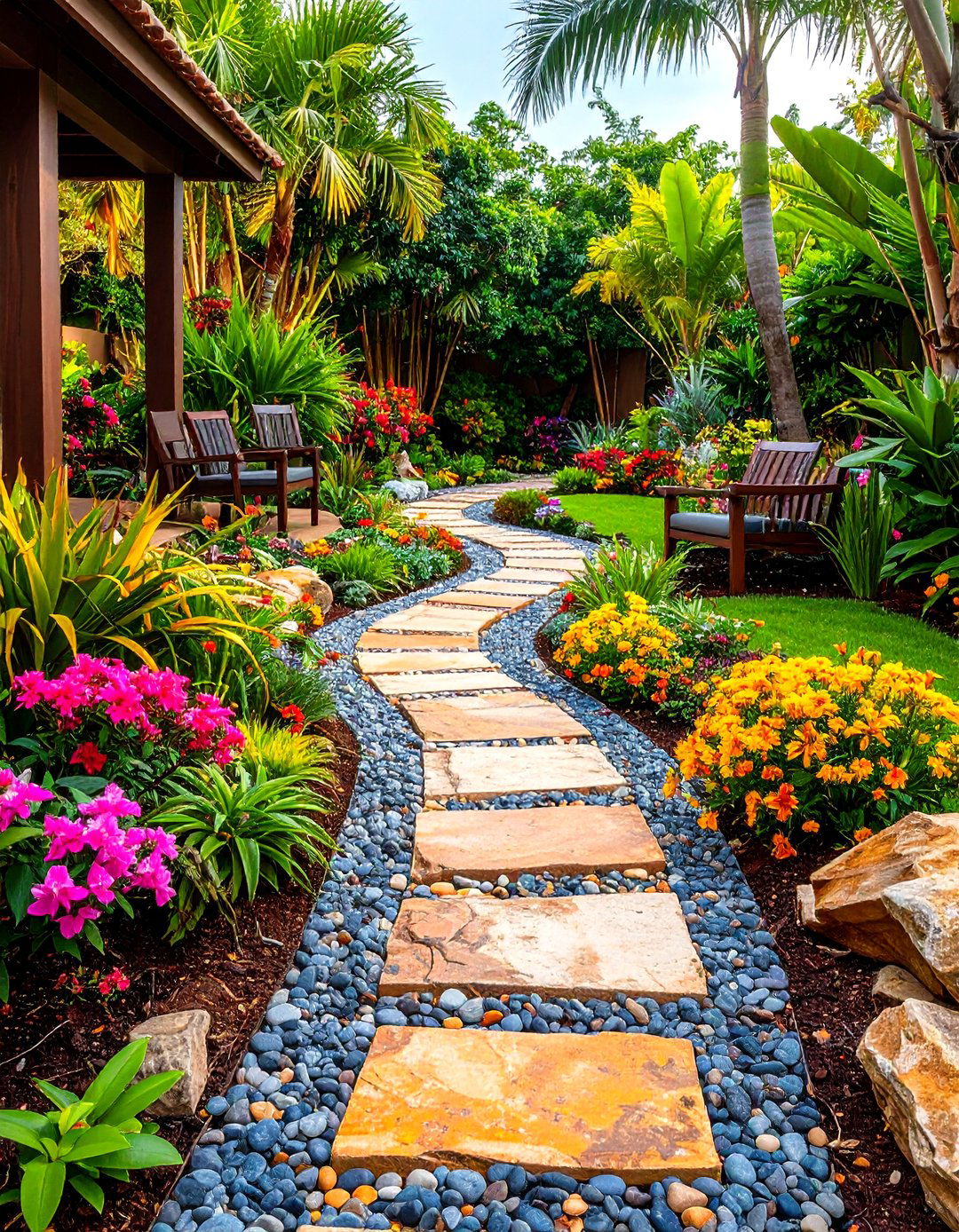
Create immersive tropical experiences through winding pathways that reveal sequential garden scenes designed to surprise and delight visitors. Establish curved walkways using materials like decomposed granite, stepping stones, or wooden boardwalks that encourage leisurely exploration rather than direct transit. Line pathways with varying tropical plantings that change character through different garden zones, from dense bamboo groves to open palm areas to intimate flowering gardens. Include strategic seating areas positioned at pathway turns or destination points where visitors can pause to appreciate specific garden views or rest in shaded retreats. Add water features, sculpture, or other focal points that provide pathway destinations while enhancing the journey experience. This sequential approach creates tropical gardens that unfold gradually, offering multiple experiences within single garden spaces while encouraging visitors to slow down and fully appreciate the tropical environment through extended exploration.
16. Hibiscus-Focused Tropical Garden Blooming Showcase
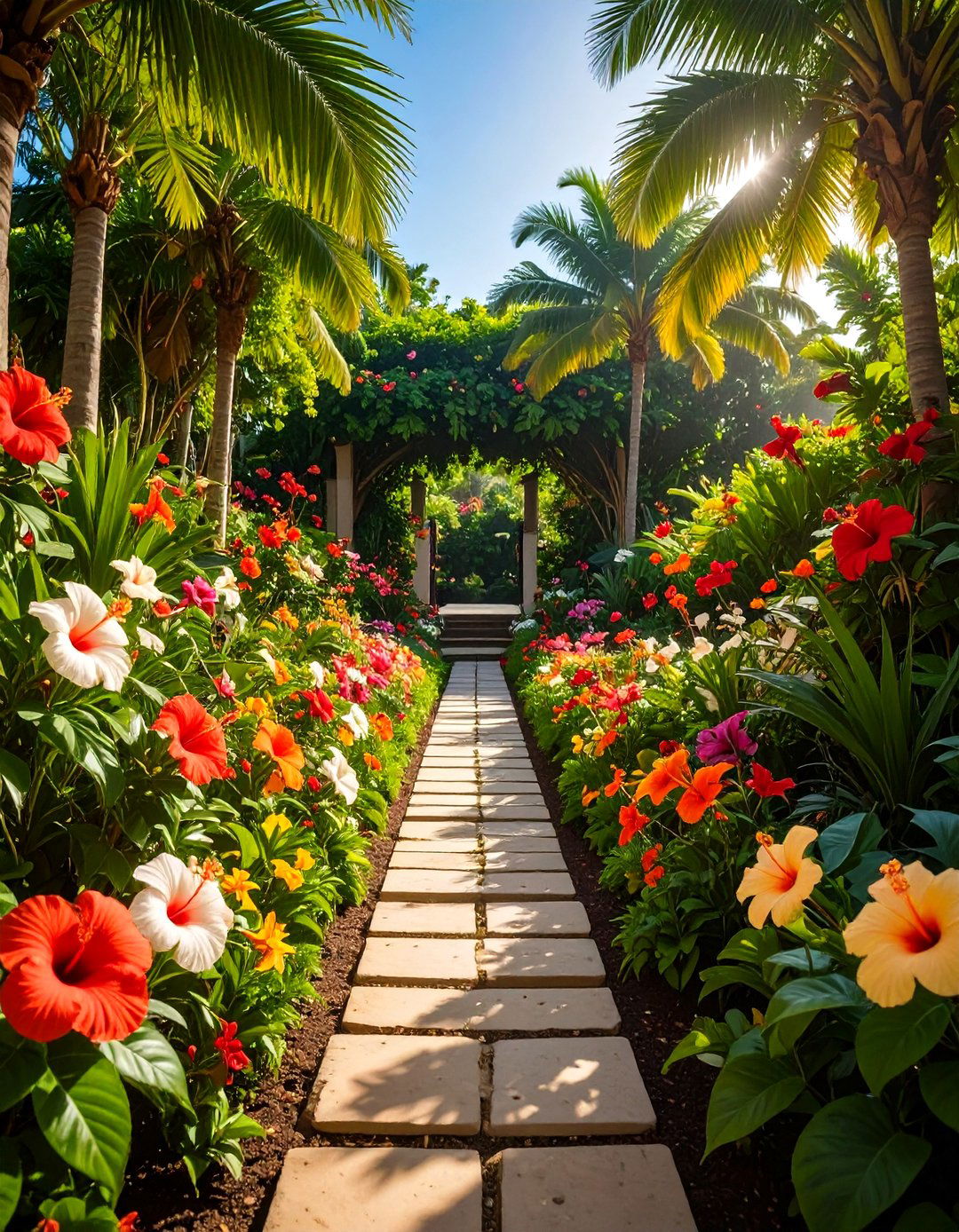
Celebrate continuous tropical color through extensive hibiscus plantings that provide reliable blooms throughout warm growing seasons. Select hibiscus varieties with different flower colors, sizes, and growth habits including compact varieties for borders, standard forms for mid-garden placement, and tree-form specimens for structural elements. Companion hibiscus with plants that complement their growth requirements including palms for structure, ornamental grasses for texture, and colorful annuals for extended season interest. Position hibiscus plantings near windows, seating areas, or entryways where their beautiful flowers can be appreciated daily while attracting hummingbirds and butterflies. Include both tropical hibiscus for intense colors and hardy varieties for year-round structure in appropriate climates. This flower-focused approach creates tropical gardens that provide constant color rewards while establishing reliable blooming patterns that justify garden maintenance efforts through extended periods of spectacular floral displays.
17. Stone and Plant Tropical Garden Balance Harmony
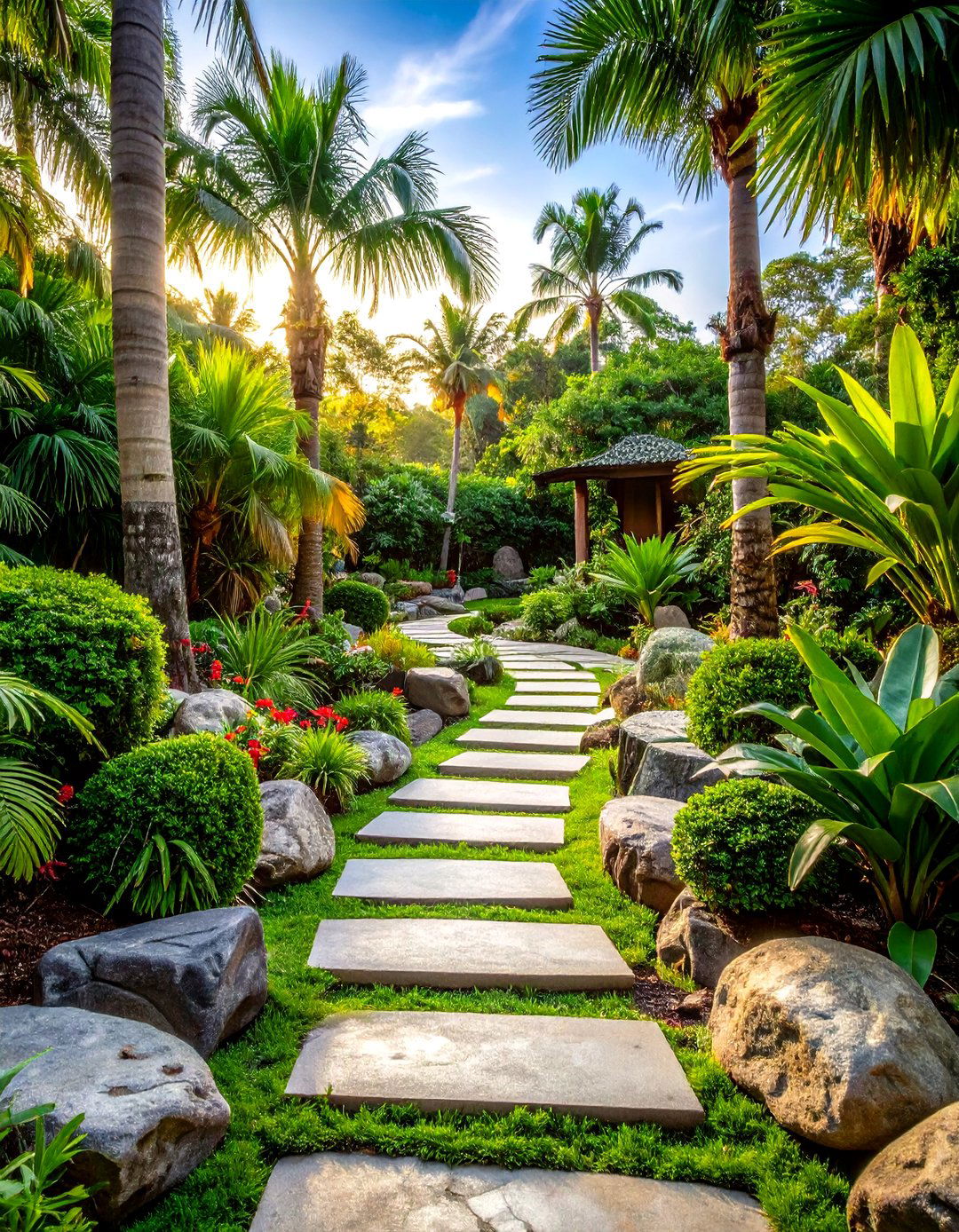
Integrate natural stone elements with tropical plantings to create sophisticated garden designs that balance hard and soft landscape features. Use natural stone for pathways, retaining walls, or decorative accents that provide structure while complementing rather than competing with tropical plants. Position palms and large architectural plants near stone features to soften hard edges while creating pleasing contrasts between organic and mineral elements. Include stone water features like natural-looking ponds or fountains that blend seamlessly with tropical plantings while providing focal points and soothing sounds. Choose plants that complement stone colors and textures, including those with interesting bark patterns, colorful foliage, or sculptural forms that enhance the overall composition. This balanced approach creates sophisticated tropical gardens that feel both natural and designed, offering timeless appeal that improves with age as plants mature and stone develops weathered patina.
18. Succulent-Tropical Garden Fusion Innovation
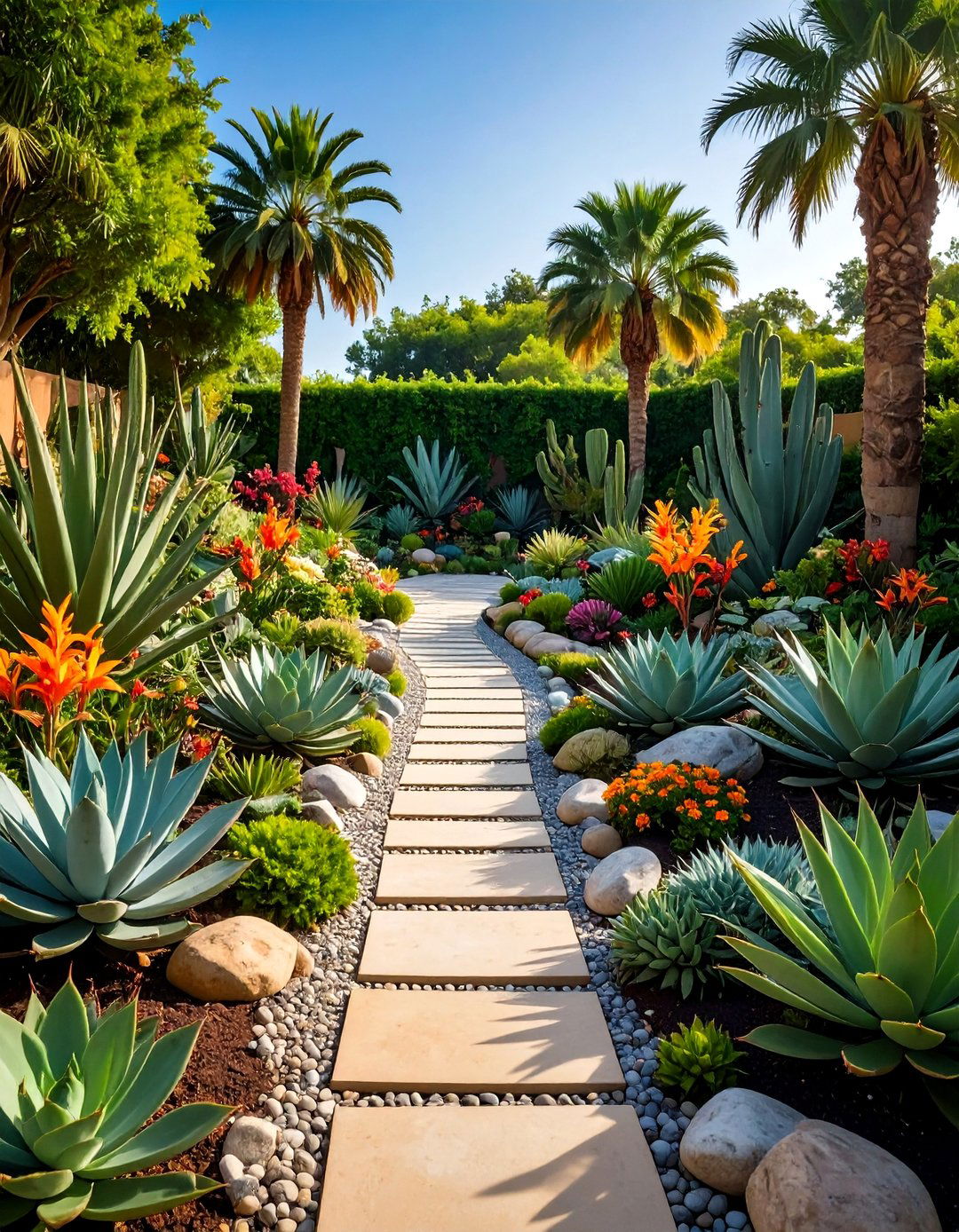
Combine drought-tolerant succulents with traditional tropical plants to create innovative garden designs that offer extended season interest while reducing water requirements. Include architectural succulents like agaves and large aloes that provide tropical-looking forms without typical tropical water needs. Mix these with traditional tropicals like palms and colorful cannas that provide authentic tropical character during growing seasons. This combination works particularly well in transitional climates where some tropical plants are marginal while succulents provide reliable year-round structure. Include container groupings that allow seasonal adjustments while maintaining cohesive design themes. Use gravel mulches and decorative stones that complement both plant types while providing efficient drainage. This fusion approach creates tropical gardens adapted to modern water-conscious gardening while maintaining exotic appeal through creative plant combinations that challenge traditional tropical garden assumptions.
19. Seasonal Tropical Garden Transition Strategy

Plan tropical gardens that adapt gracefully to changing seasons while maintaining interest and structure throughout different weather periods. Include hardy tropical plants like bamboo, cold-tolerant palms, and evergreen specimens that provide year-round structure while supporting seasonal additions. Plan for container plants that can be moved to protected locations during challenging weather while establishing permanent plantings that survive local winter conditions. Include plants with interesting winter characteristics like colorful bark, persistent foliage, or architectural forms that provide continued interest when tropical annuals are dormant. This seasonal approach creates tropical gardens that remain attractive throughout the year while maximizing plant investments through strategic selections that provide multiple seasons of value. Seasonal planning ensures tropical garden enjoyment extends beyond traditional growing seasons while maintaining authentic tropical character through careful plant selection and placement strategies.
20. Wildlife-Friendly Tropical Garden Ecosystem Haven

Design tropical gardens that support local wildlife while providing exotic beauty through plant selections that offer food, shelter, and nesting opportunities for birds, butterflies, and beneficial insects. Include flowering tropicals like hibiscus, pentas, and salvias that provide nectar sources for hummingbirds and butterflies throughout growing seasons. Plant native tropical species where possible that support local wildlife populations while maintaining authentic tropical aesthetics. Include water features that provide drinking and bathing opportunities for birds while creating focal points within garden designs. Choose plants with berries, seeds, or other wildlife food sources that extend garden value beyond human enjoyment. This ecological approach creates tropical gardens that contribute to local environmental health while providing educational opportunities for observing wildlife behavior and supporting biodiversity in urban and suburban environments.
Conclusion:
These twenty tropical garden concepts demonstrate the versatility and appeal of exotic outdoor design across various spaces, budgets, and climate conditions. From dramatic water features to intimate container gardens, each approach offers unique benefits while maintaining the essential tropical character that transforms ordinary yards into extraordinary escapes. Success comes from selecting appropriate plants for your specific conditions while embracing the bold, colorful spirit that defines tropical gardening. Whether you implement one complete concept or blend elements from multiple ideas, tropical gardens provide daily reminders of paradise destinations while creating valuable outdoor living spaces.


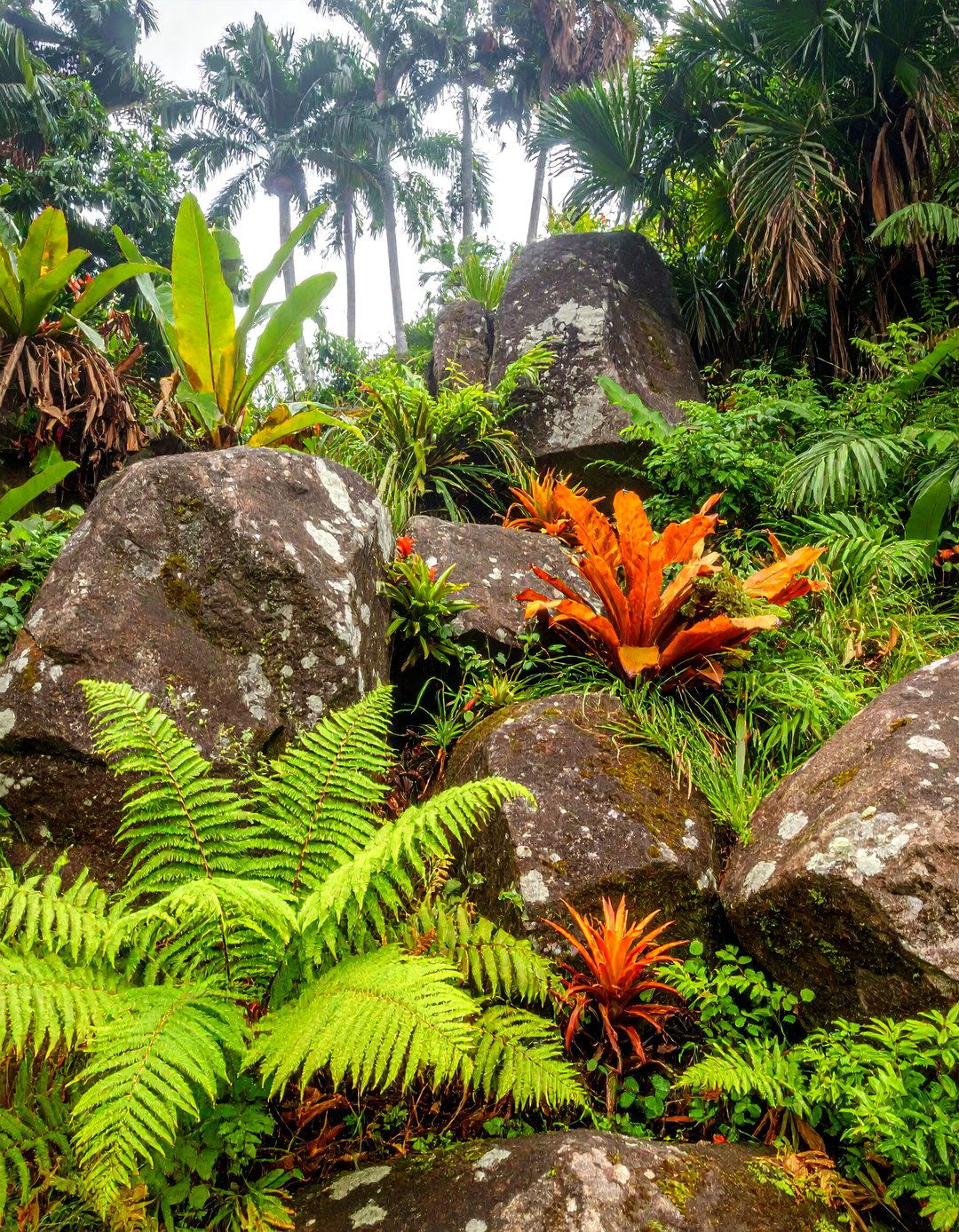
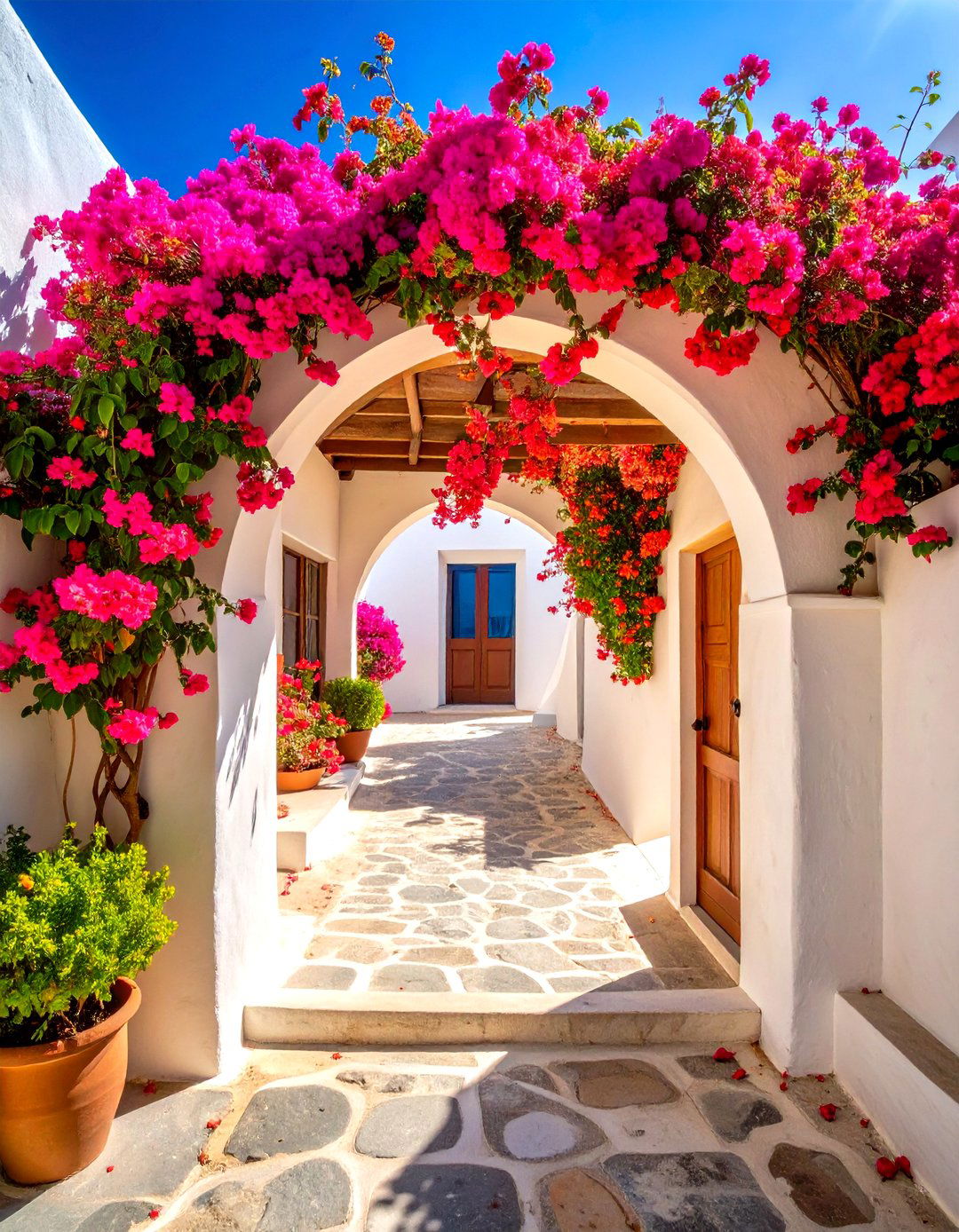

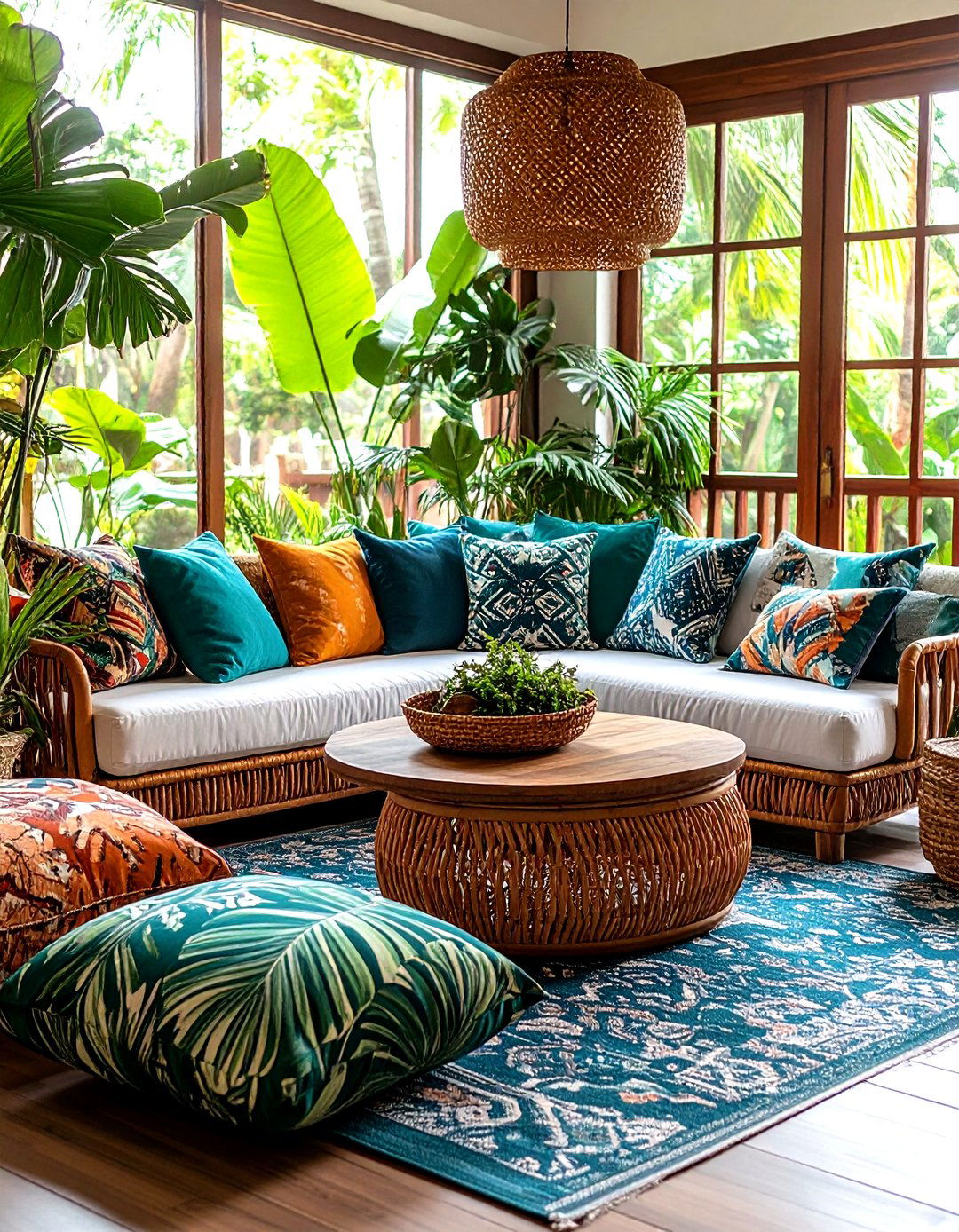
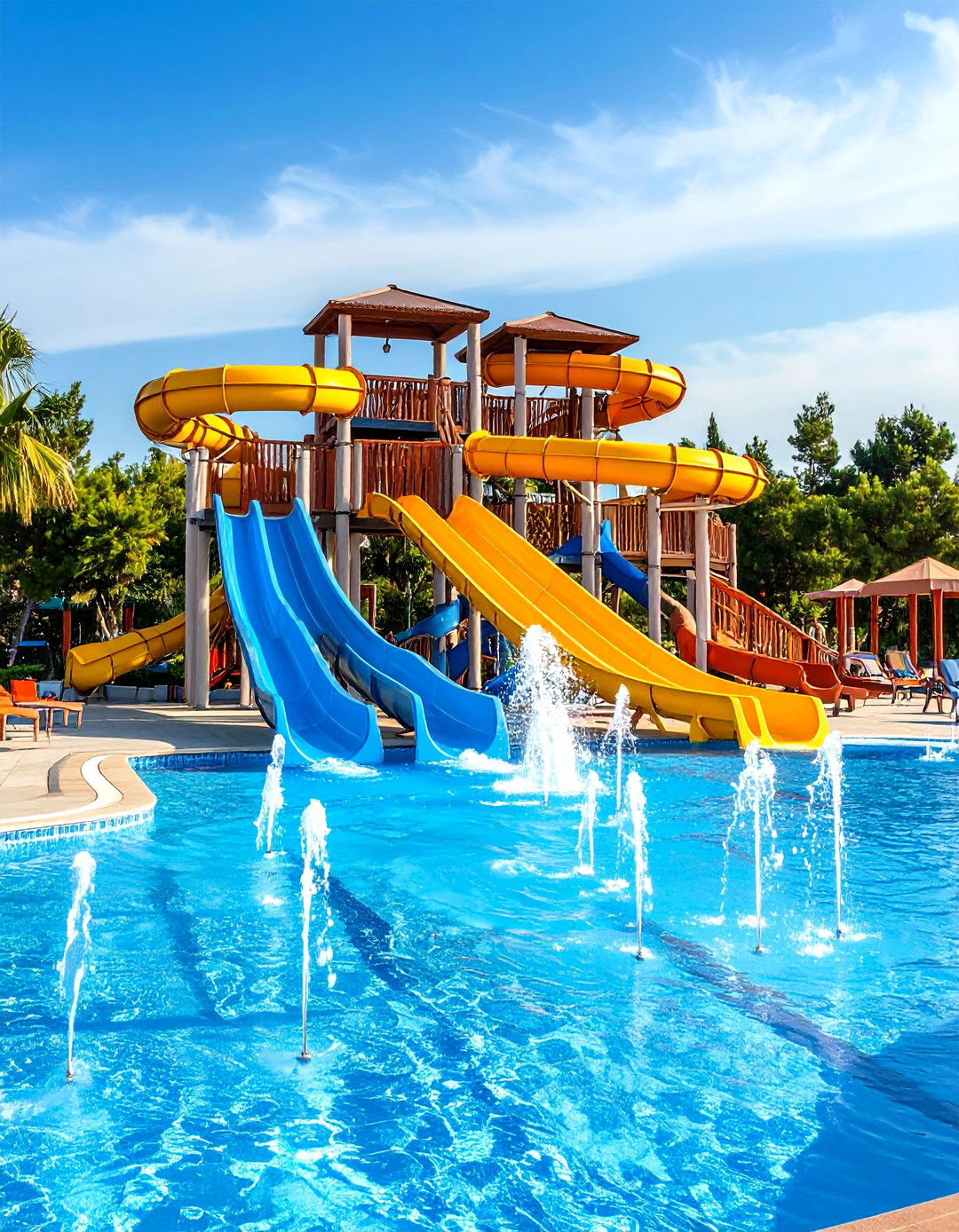
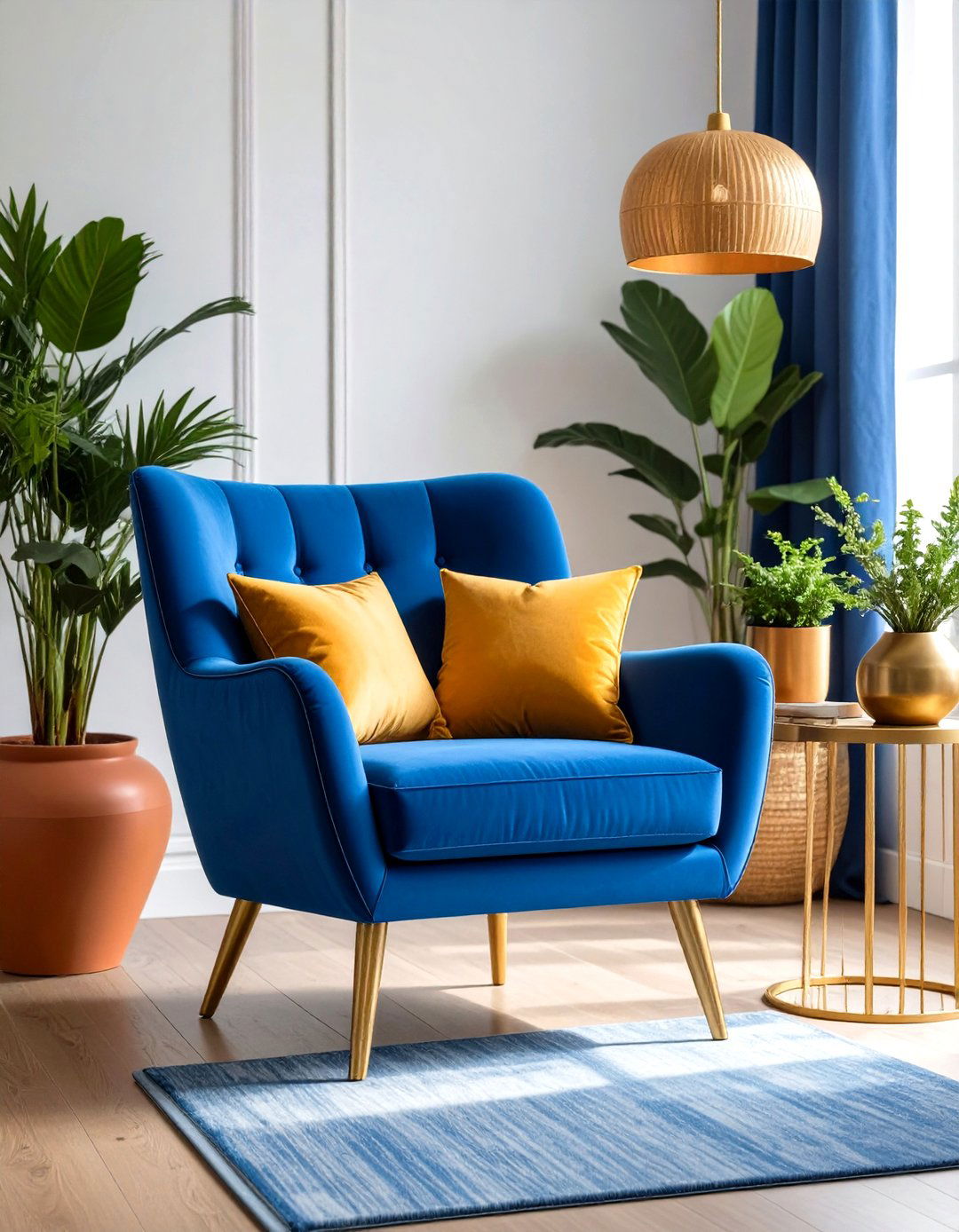
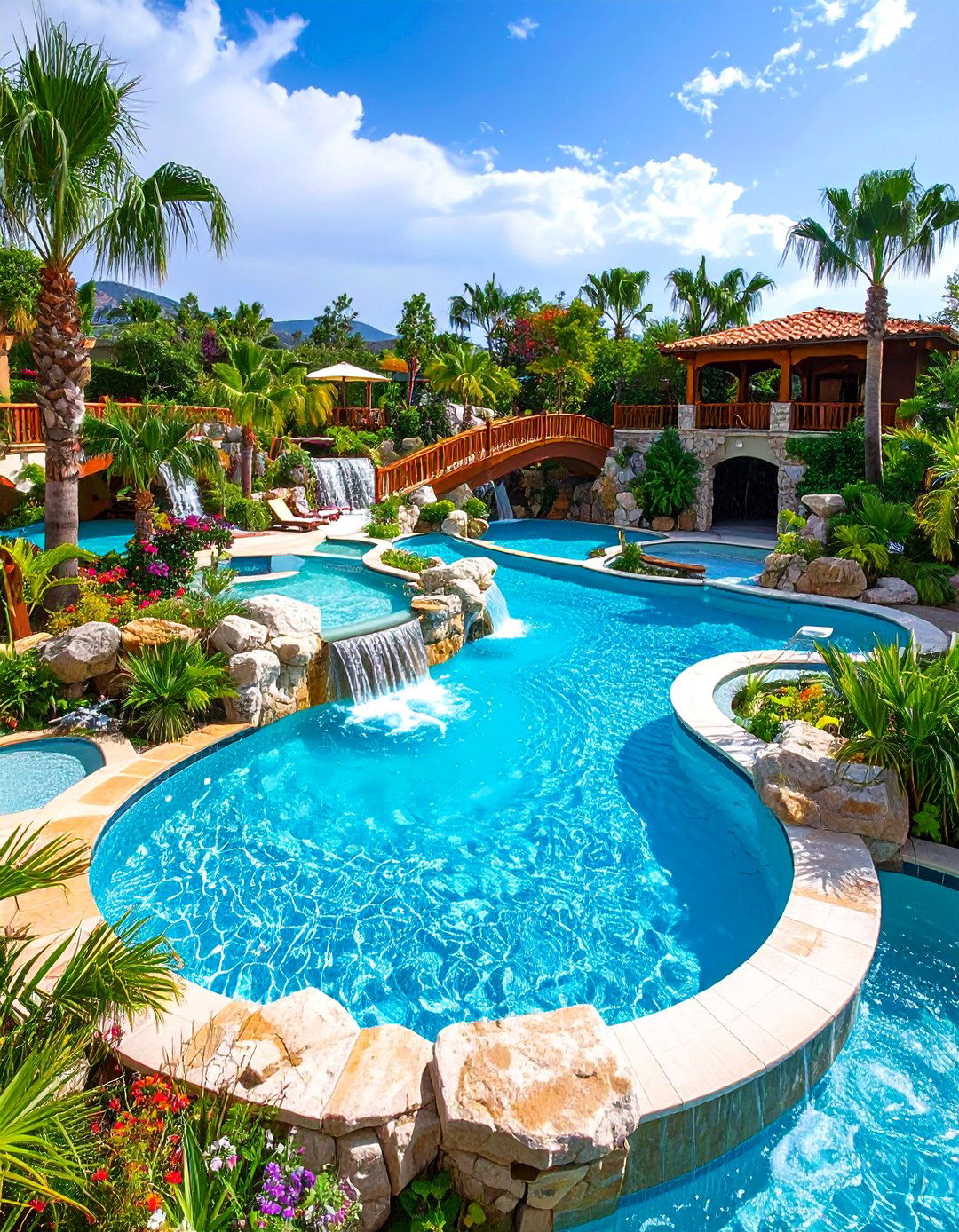
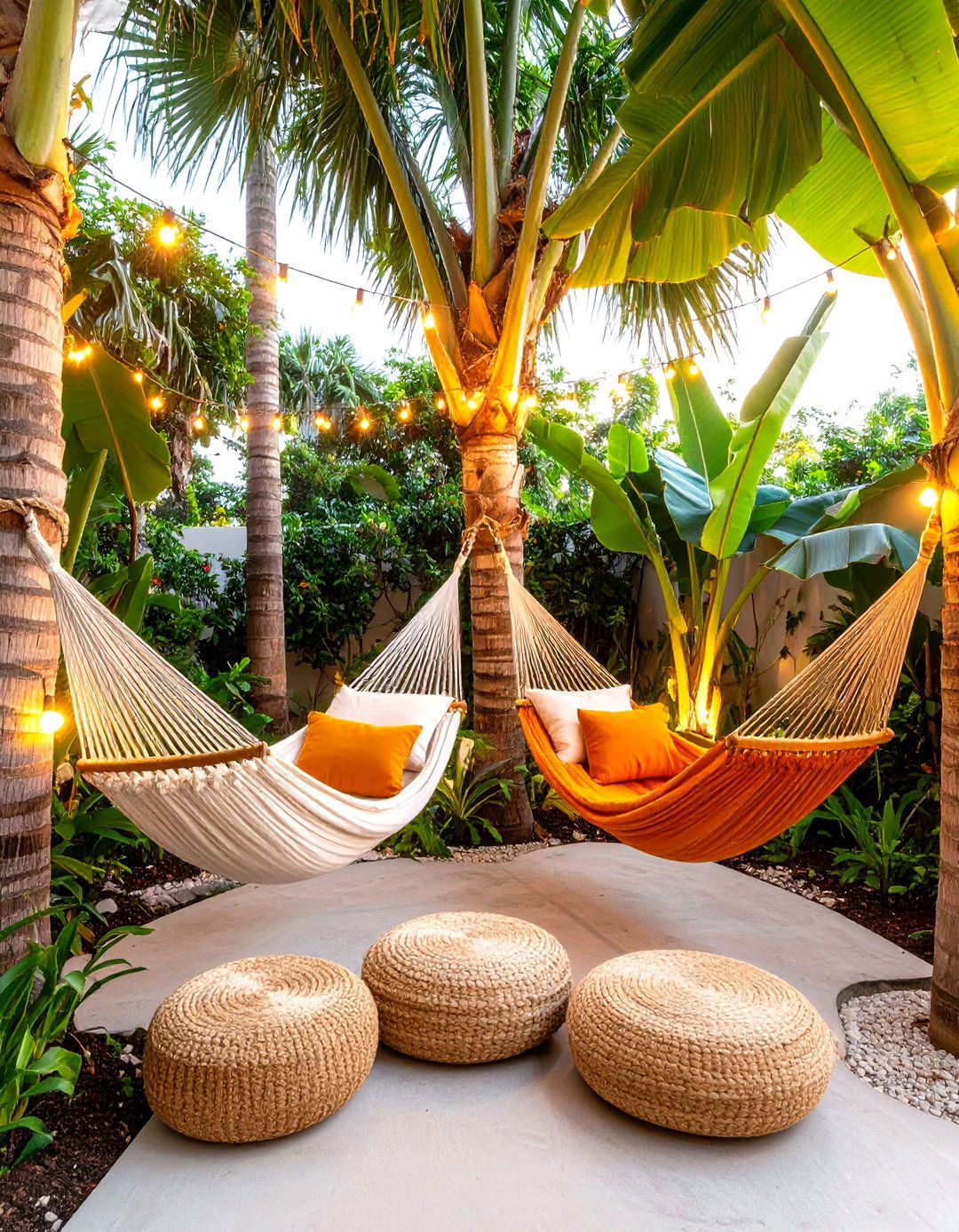

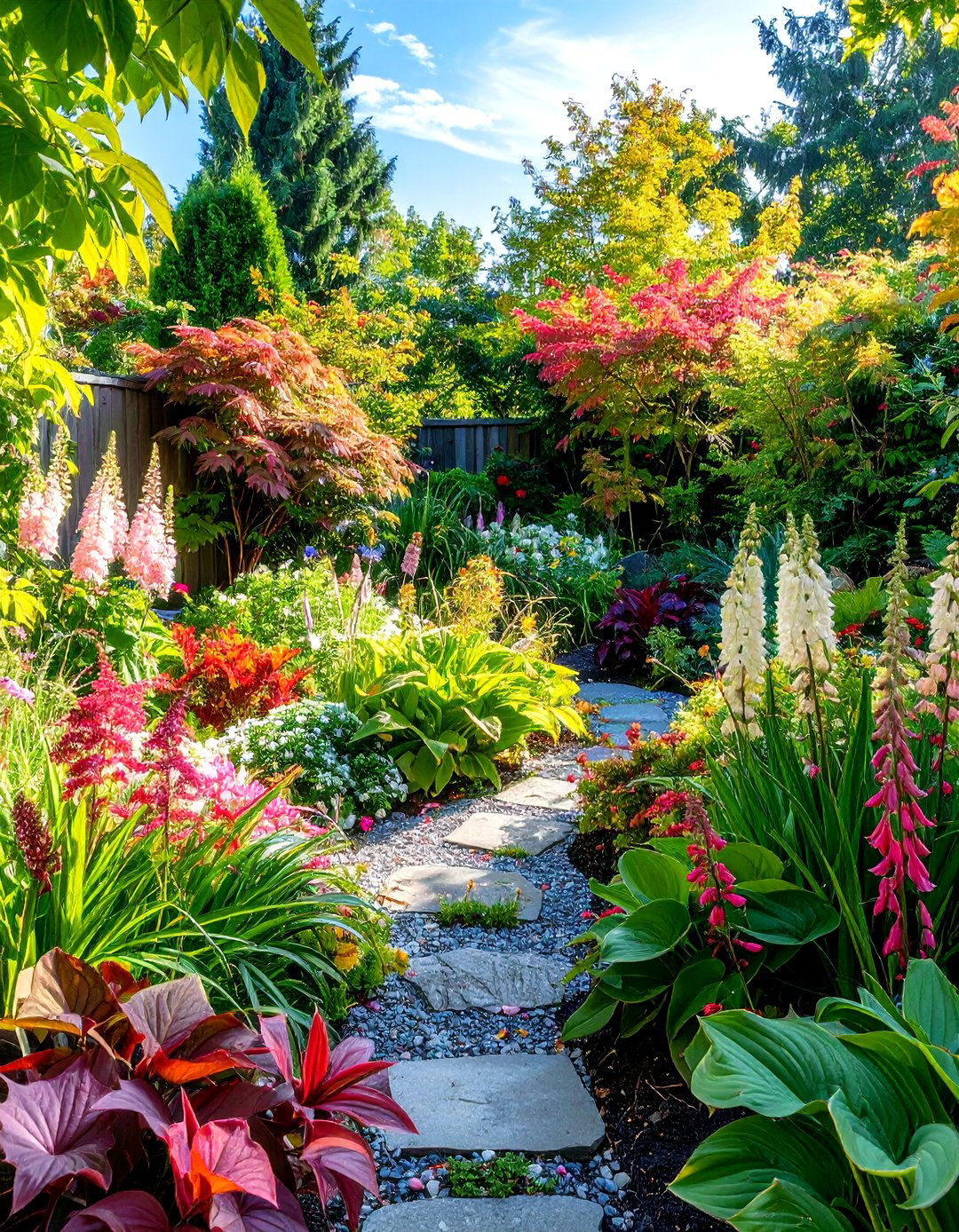
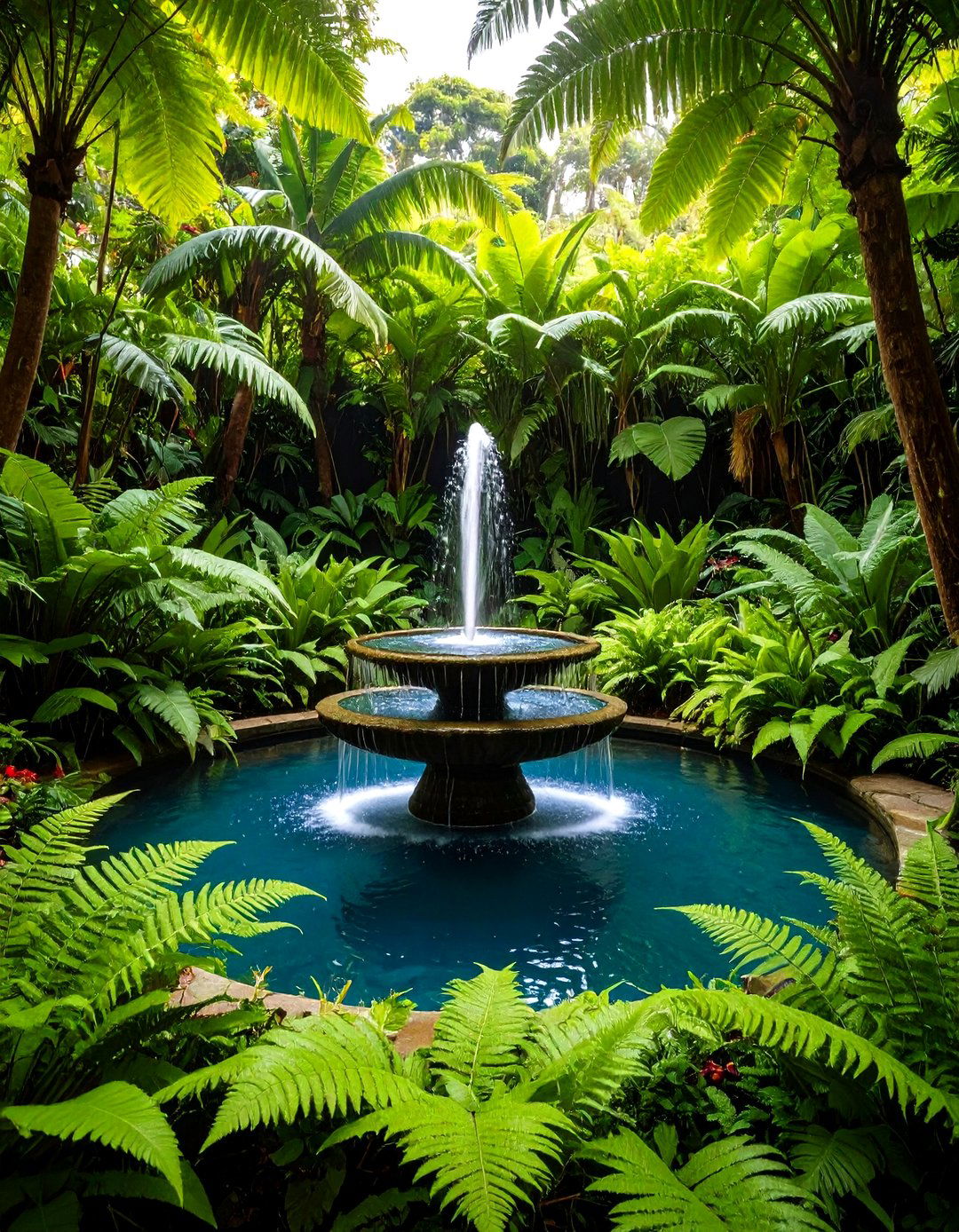

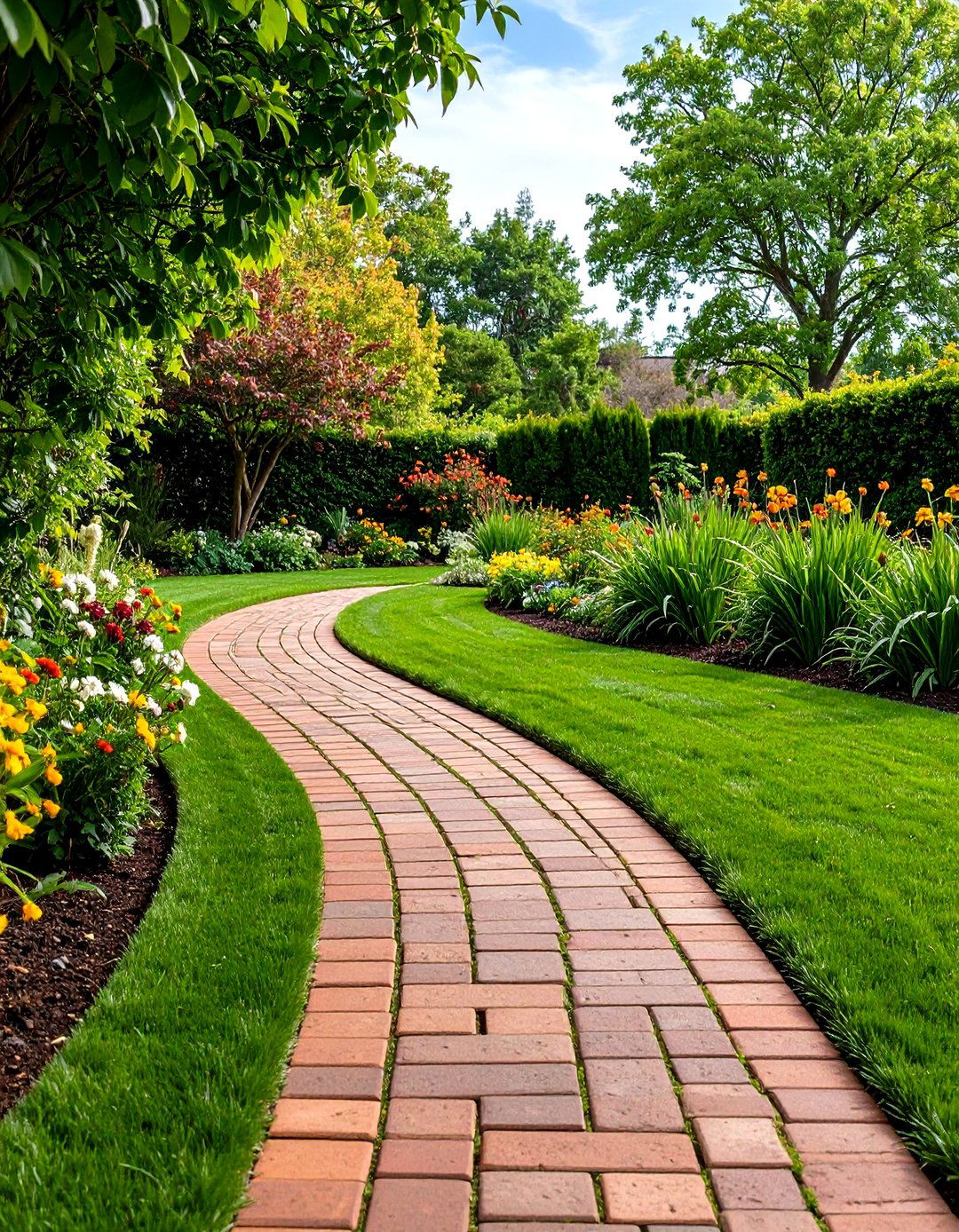
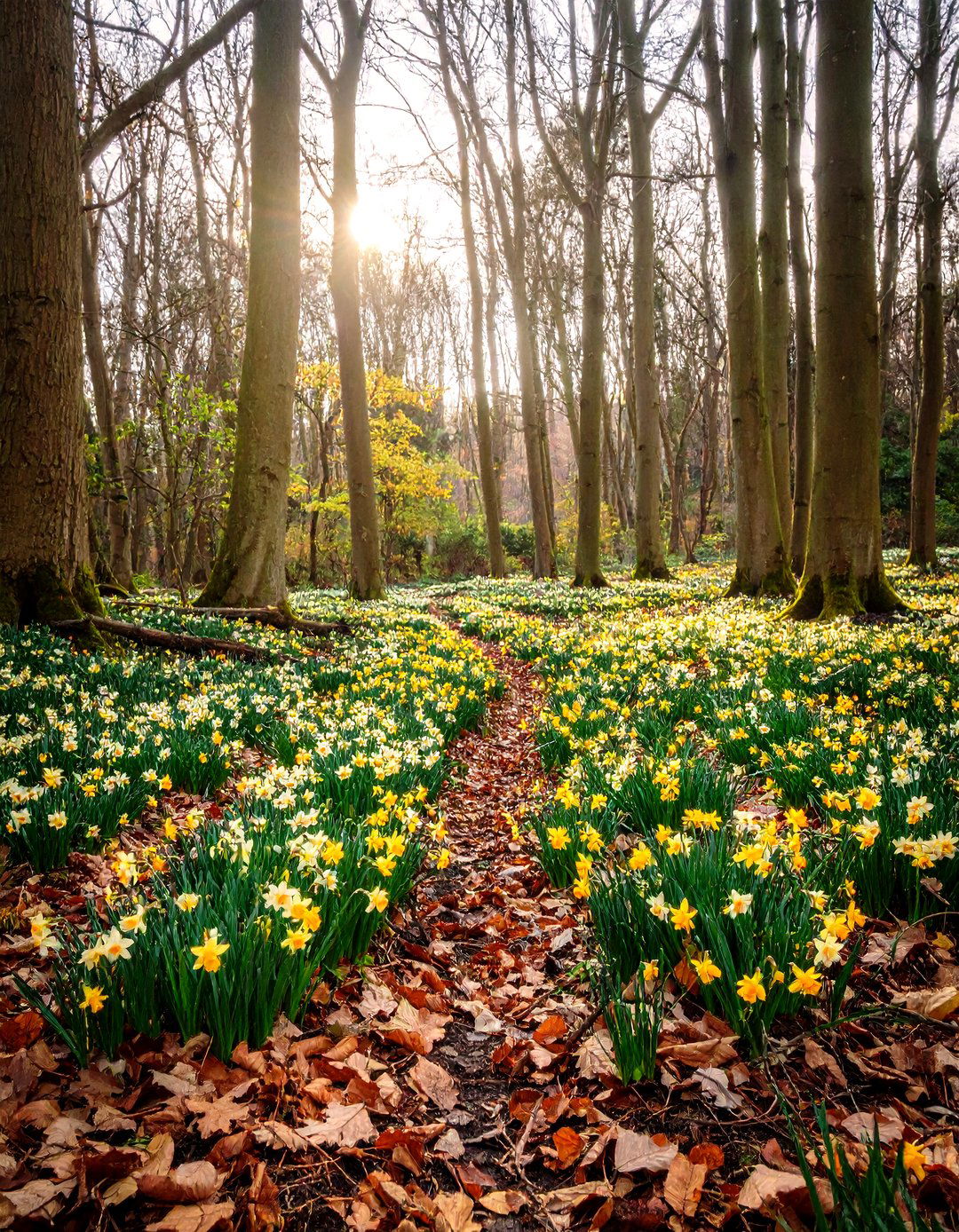
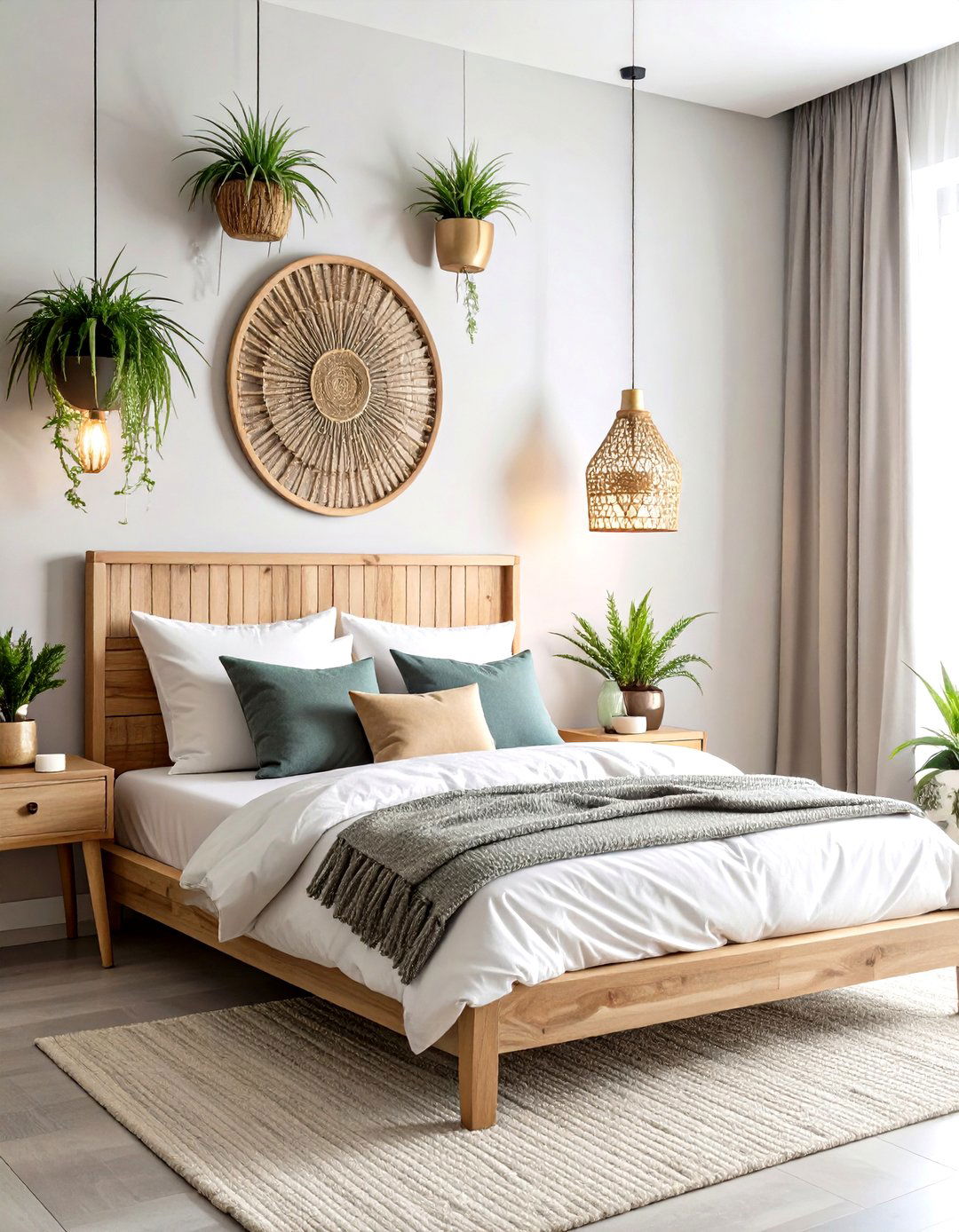
Leave a Reply